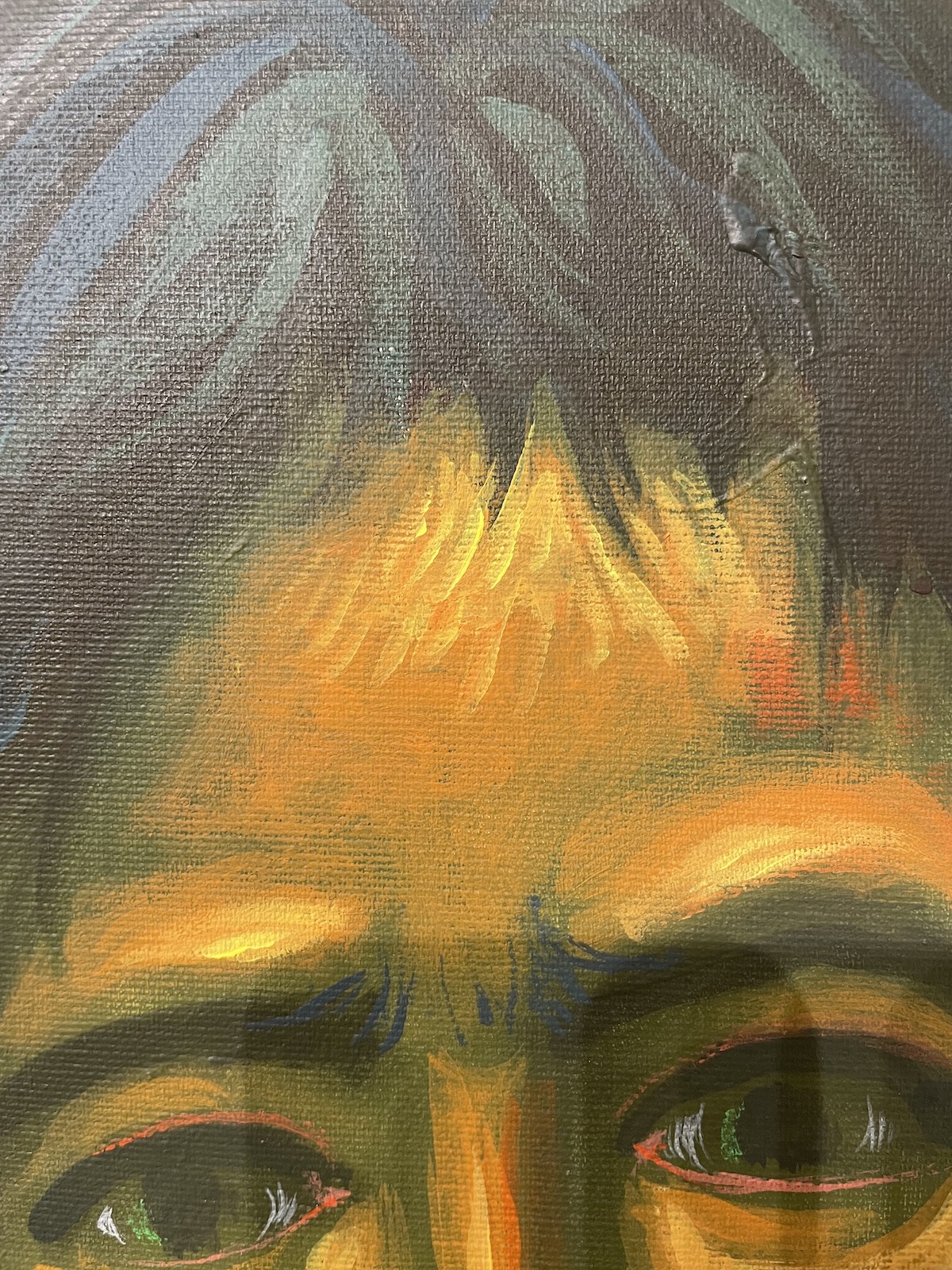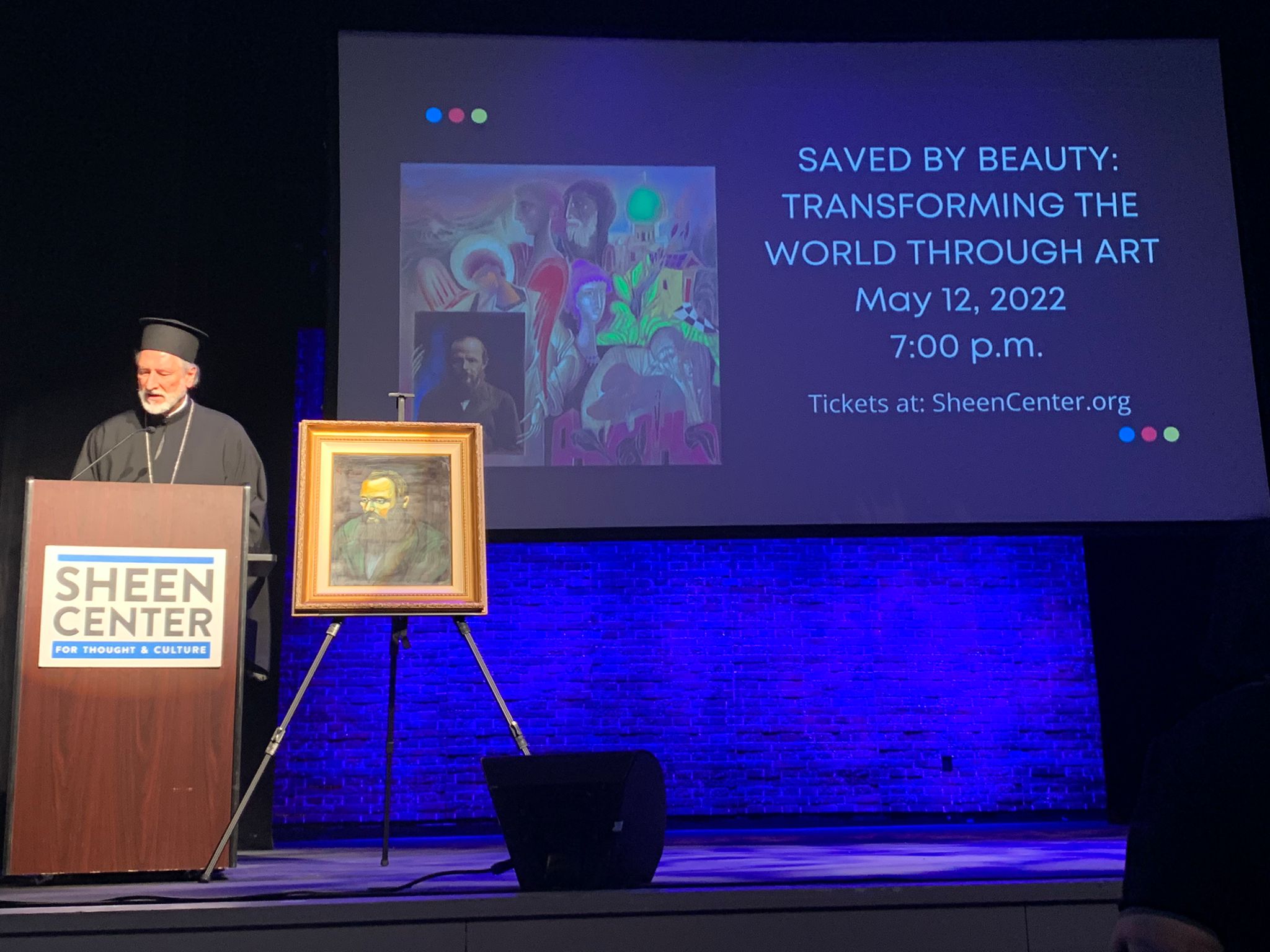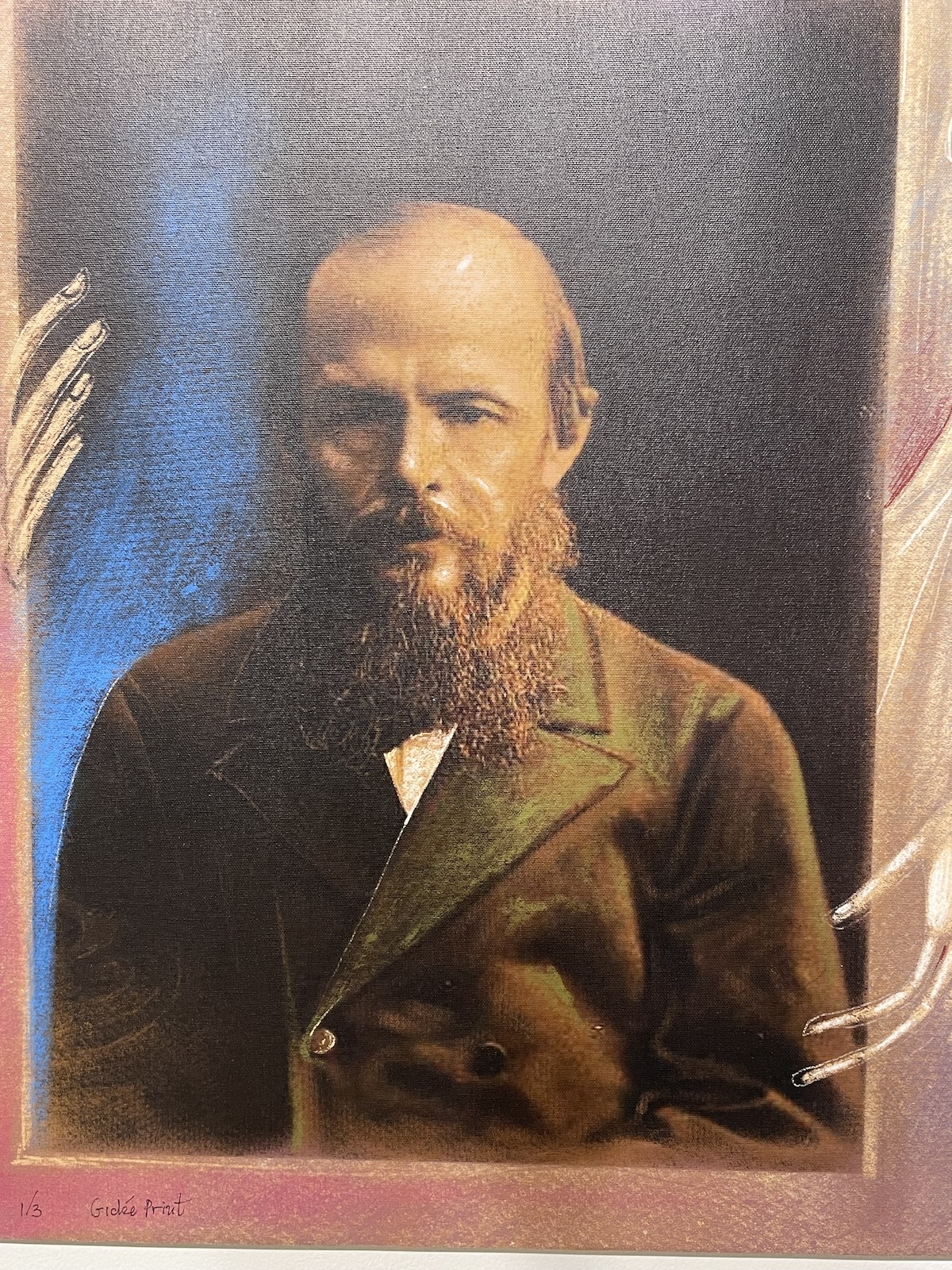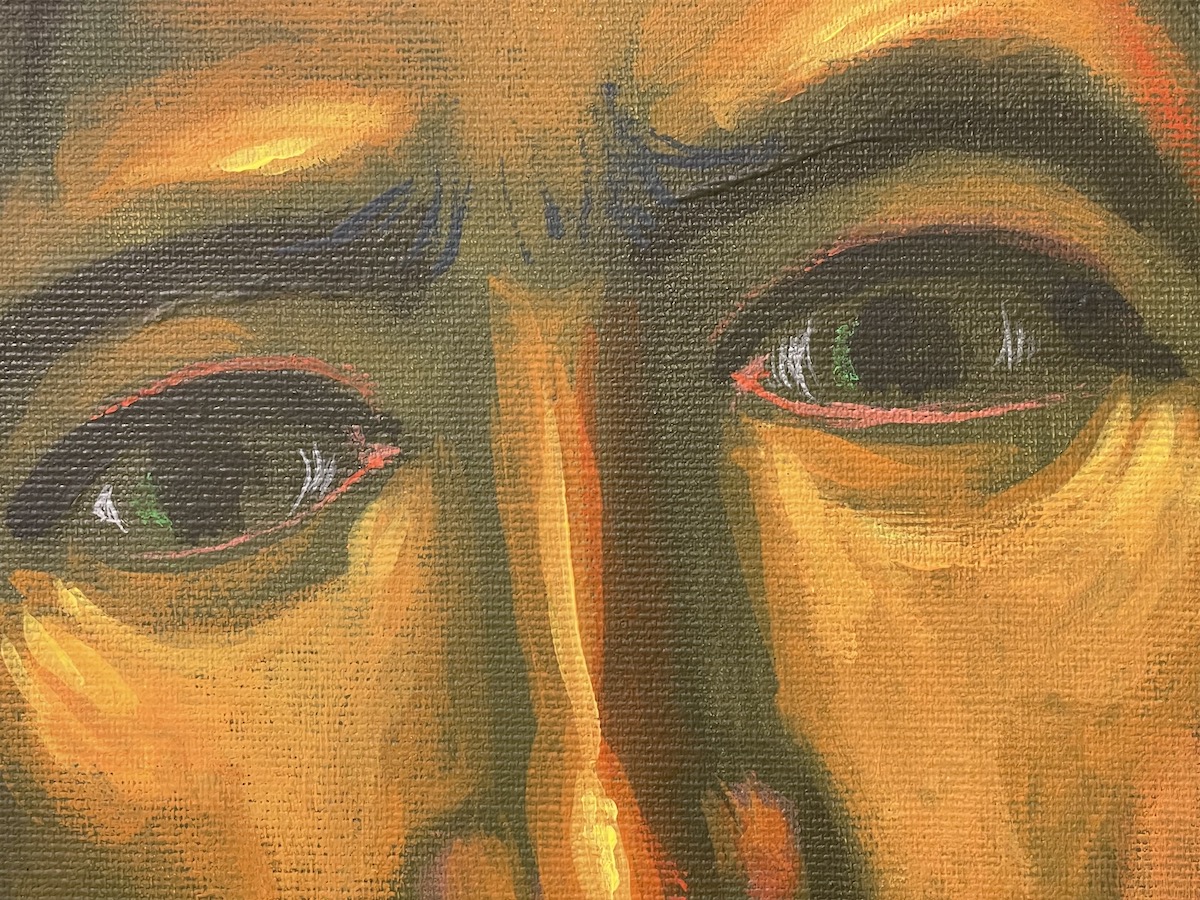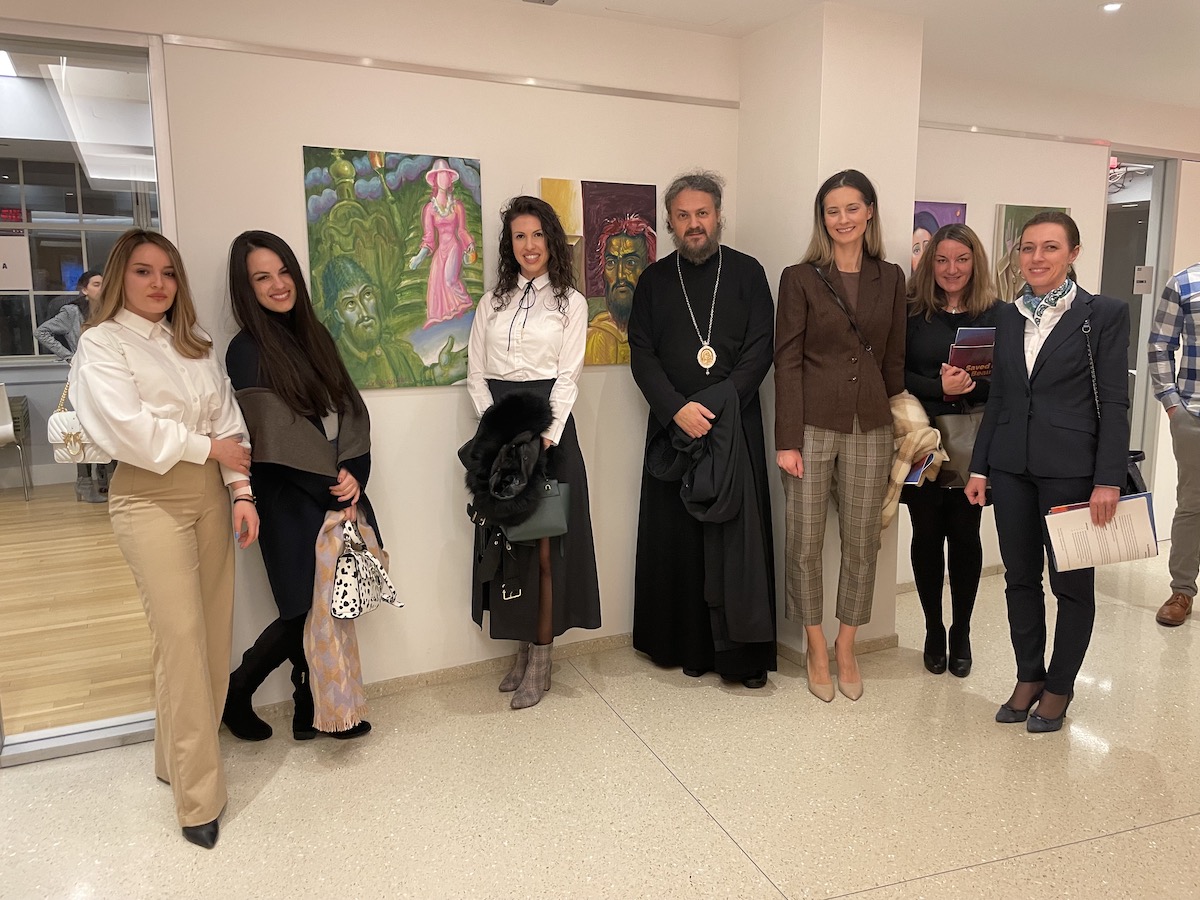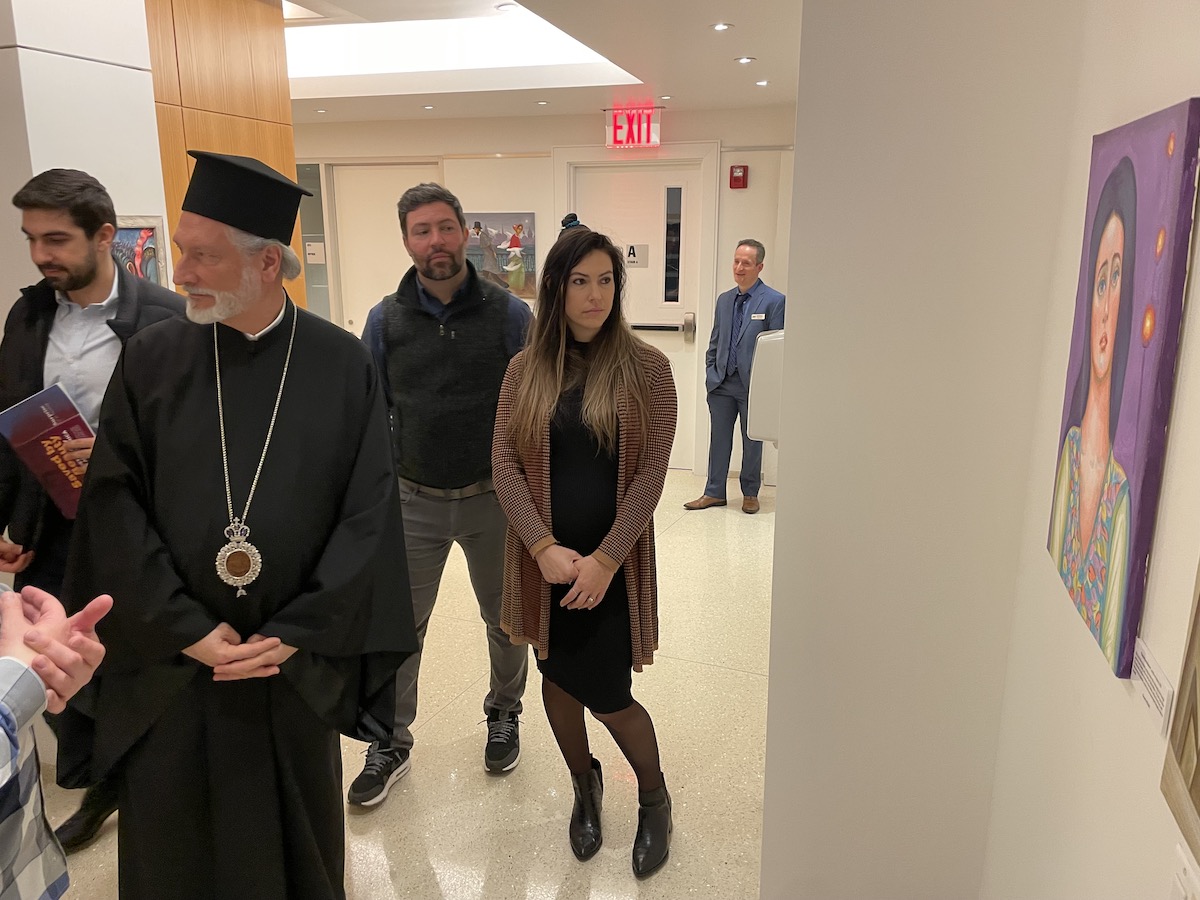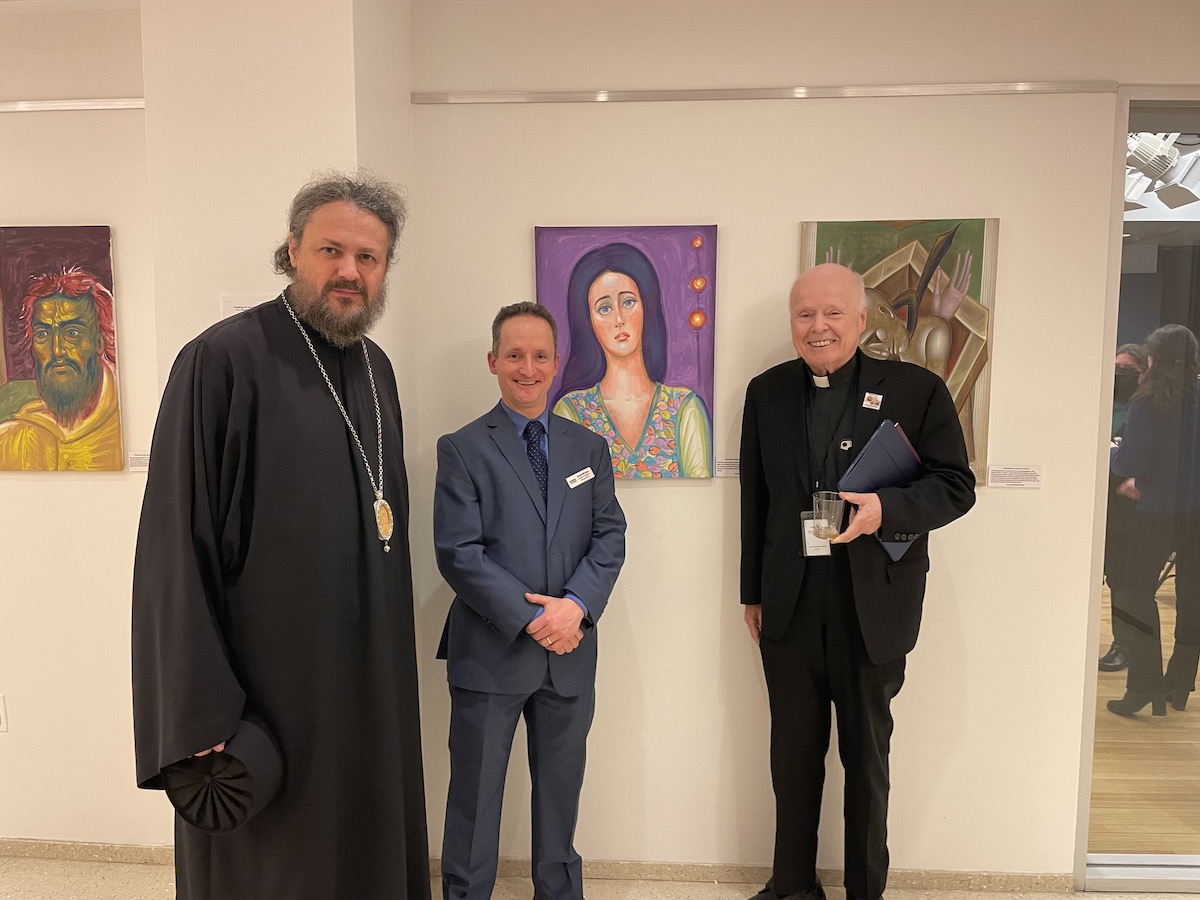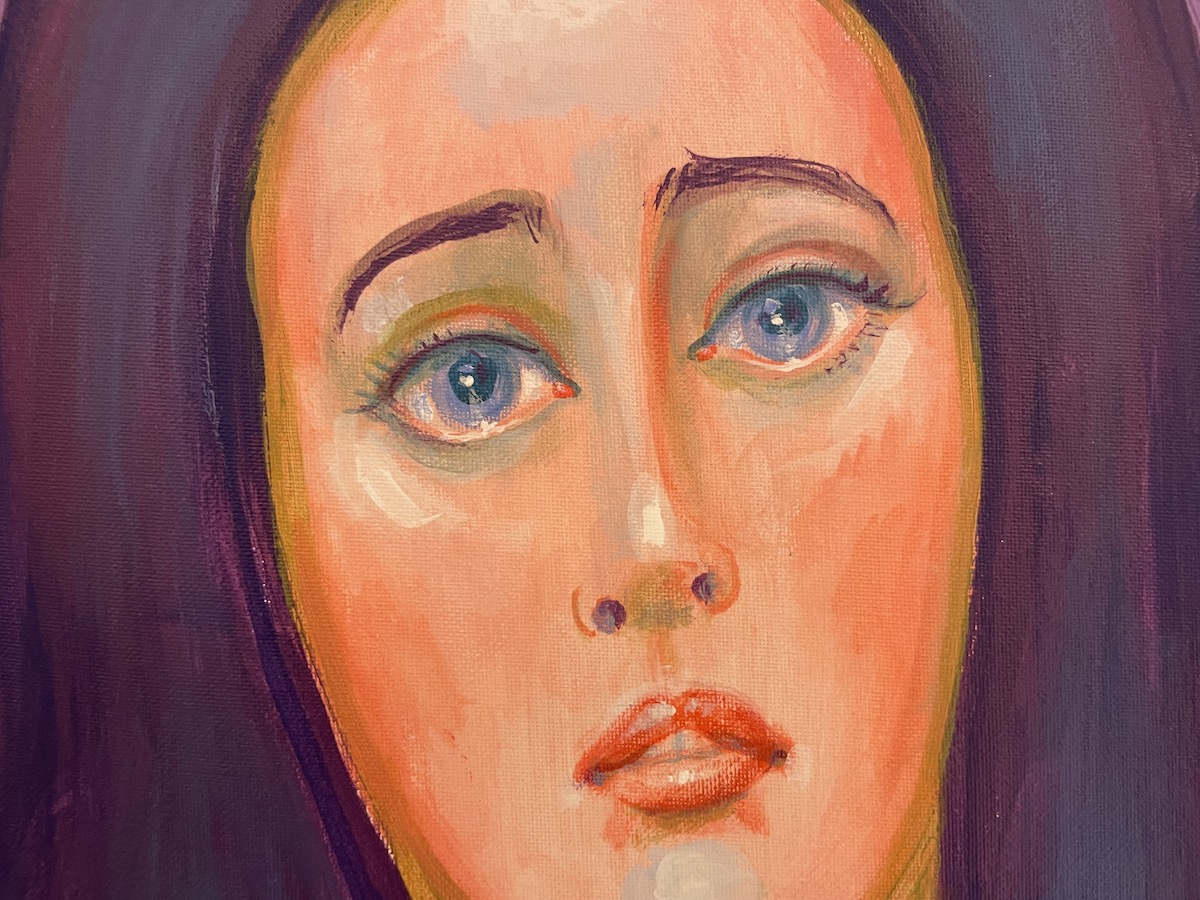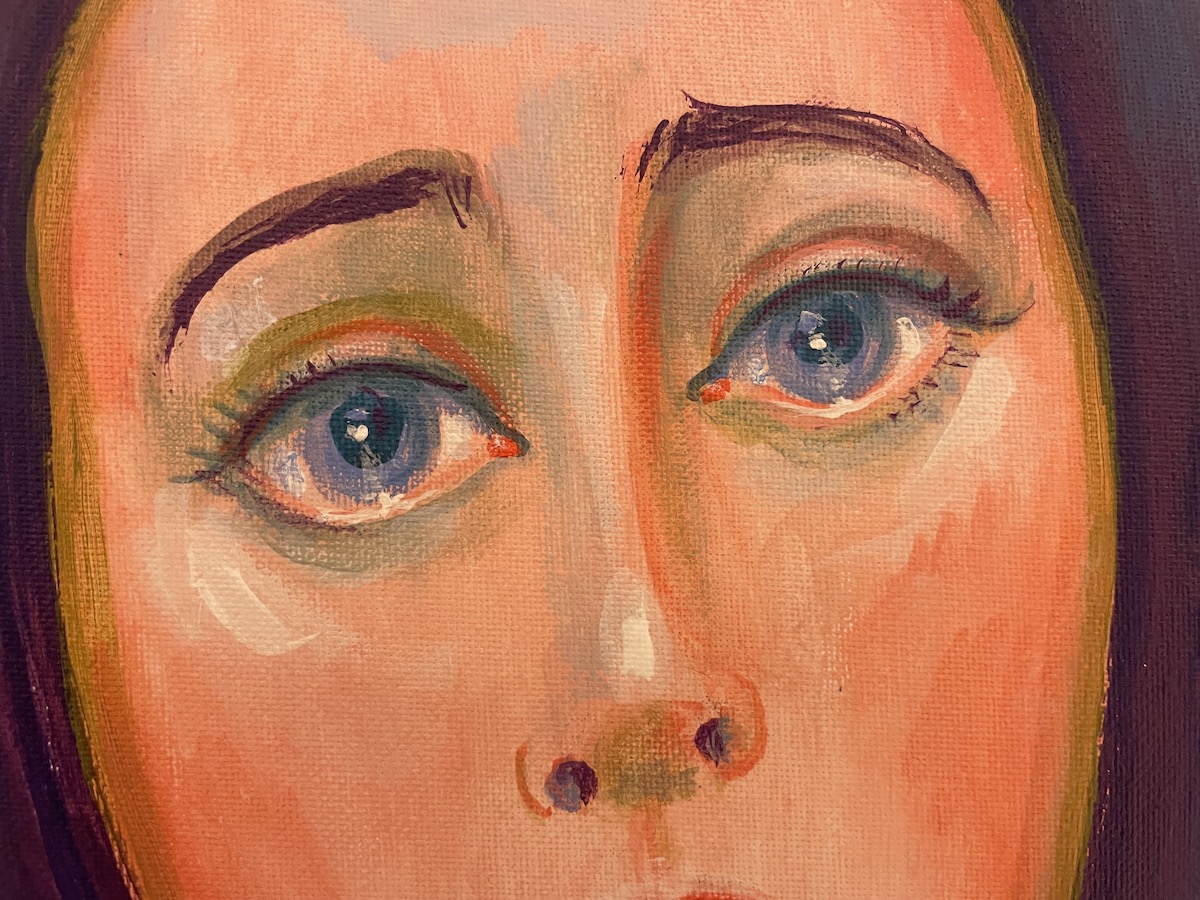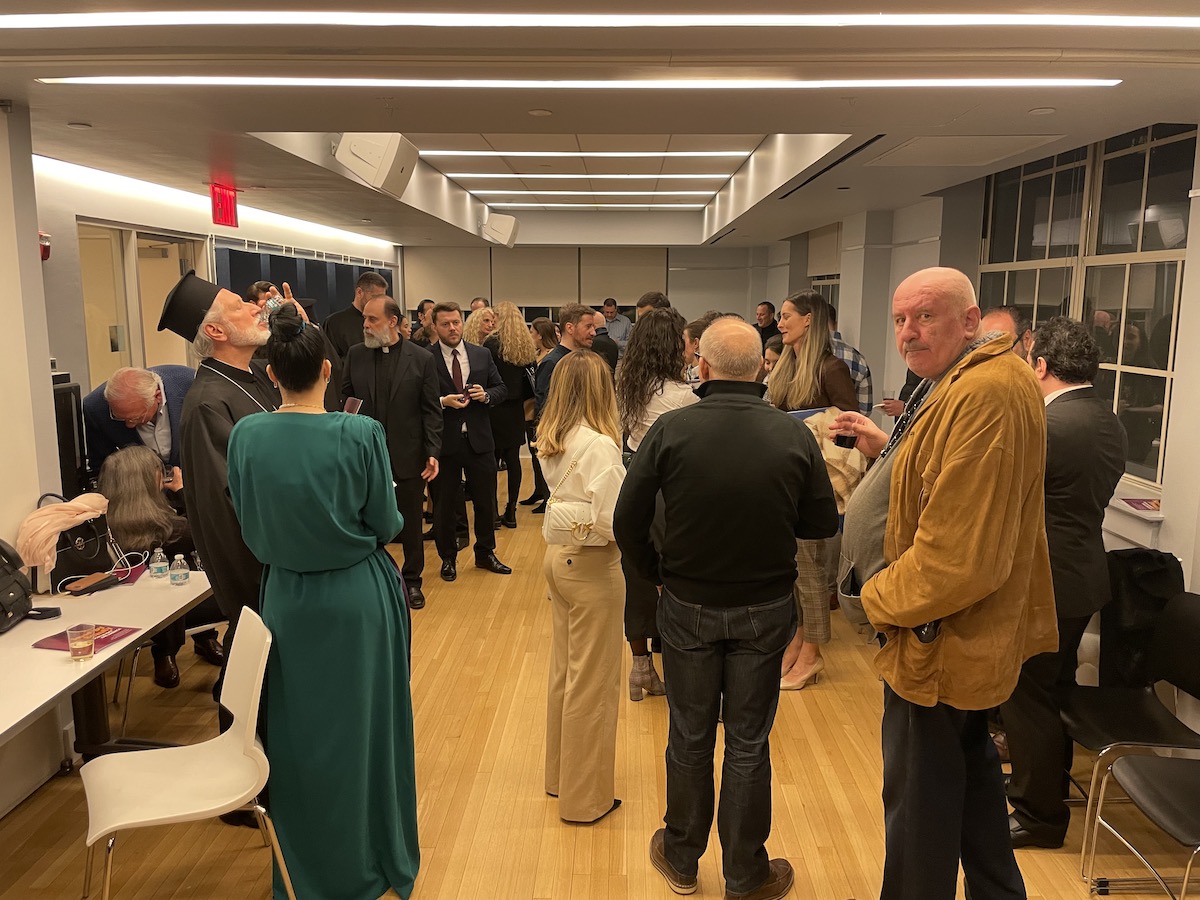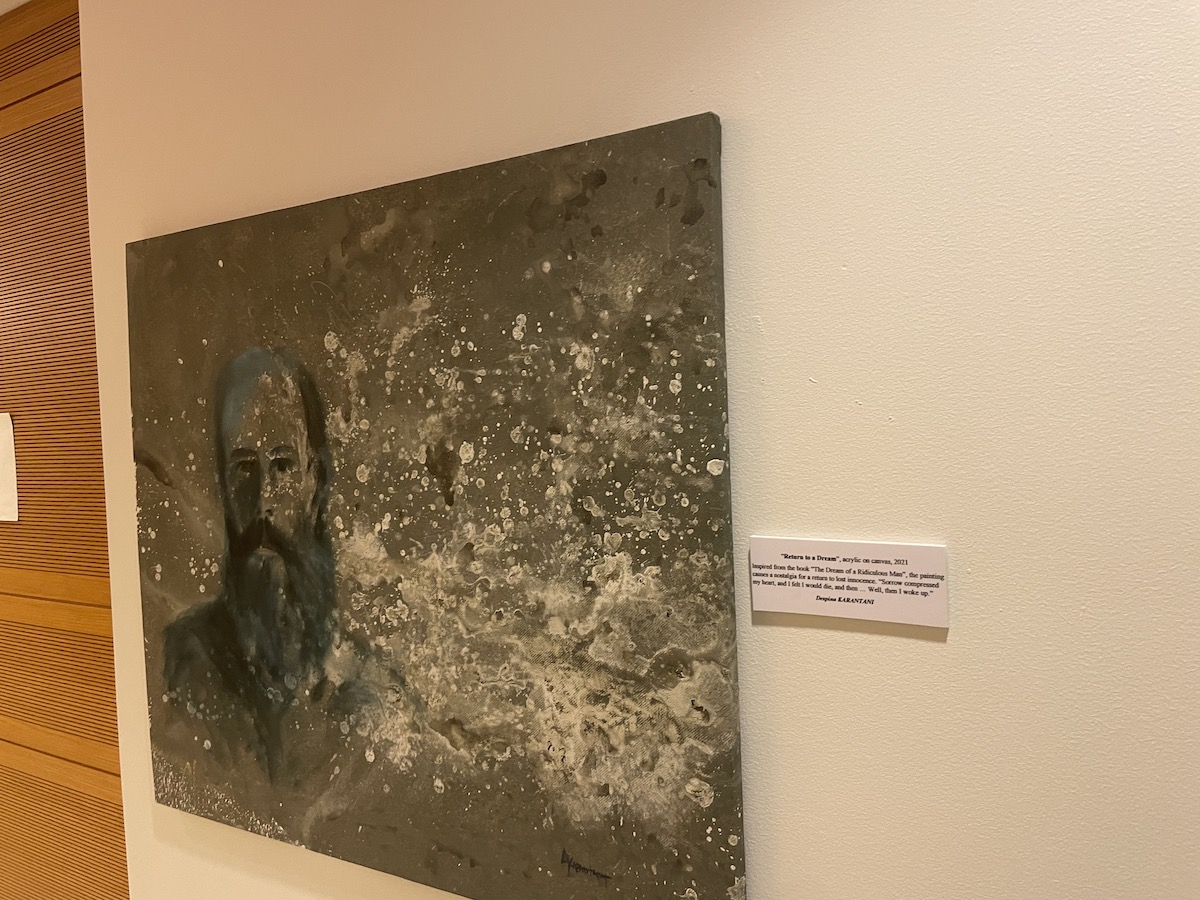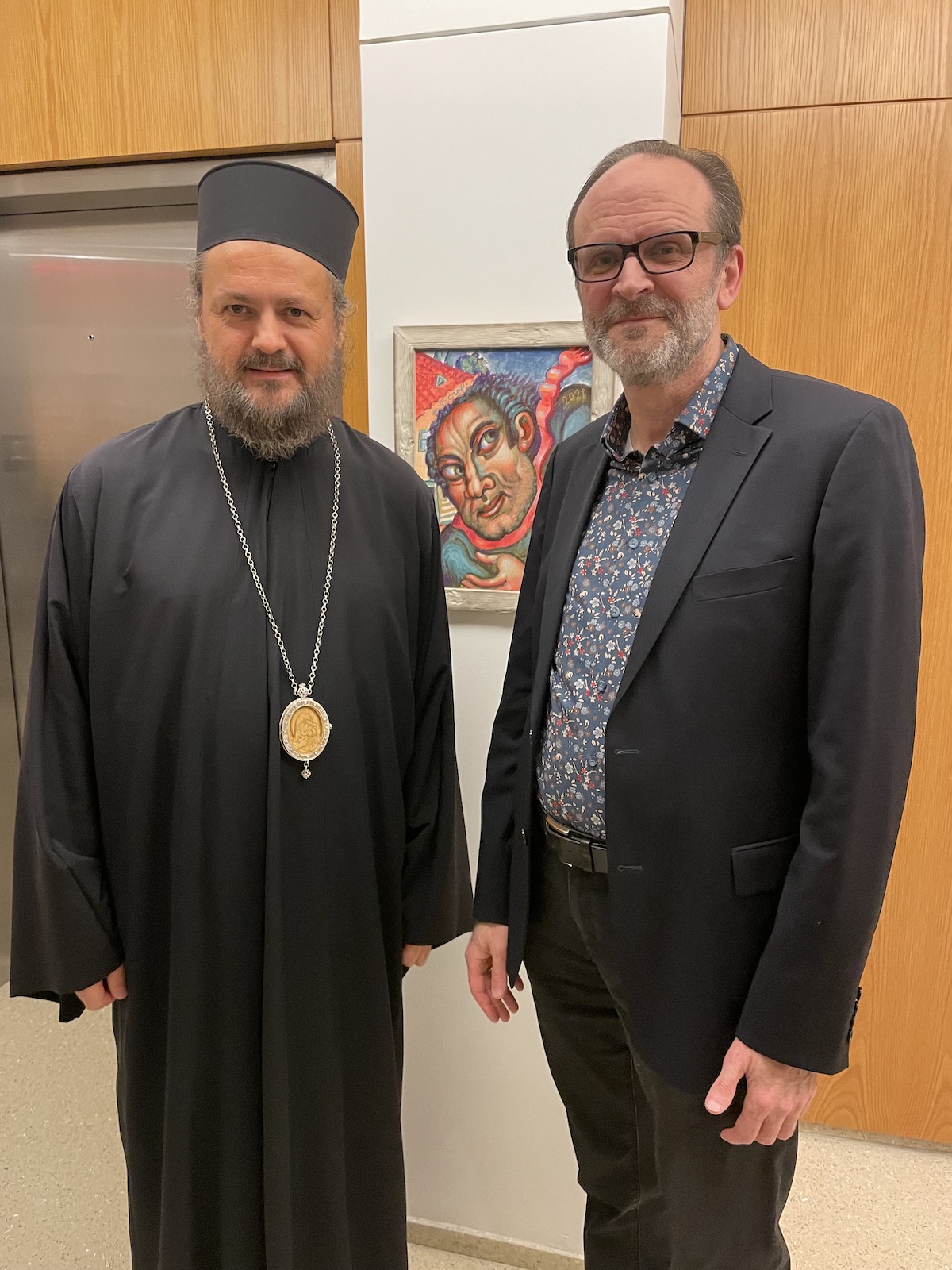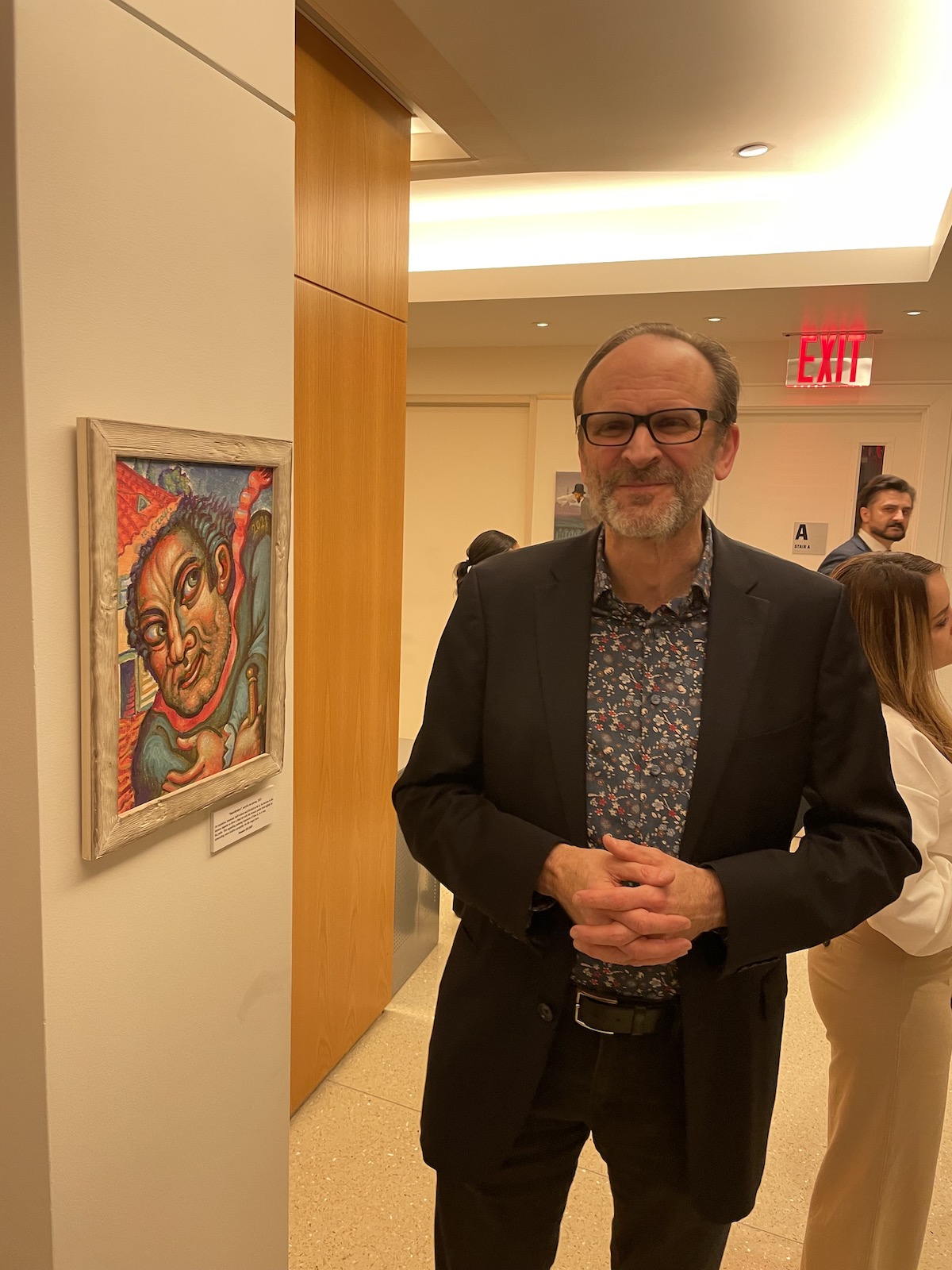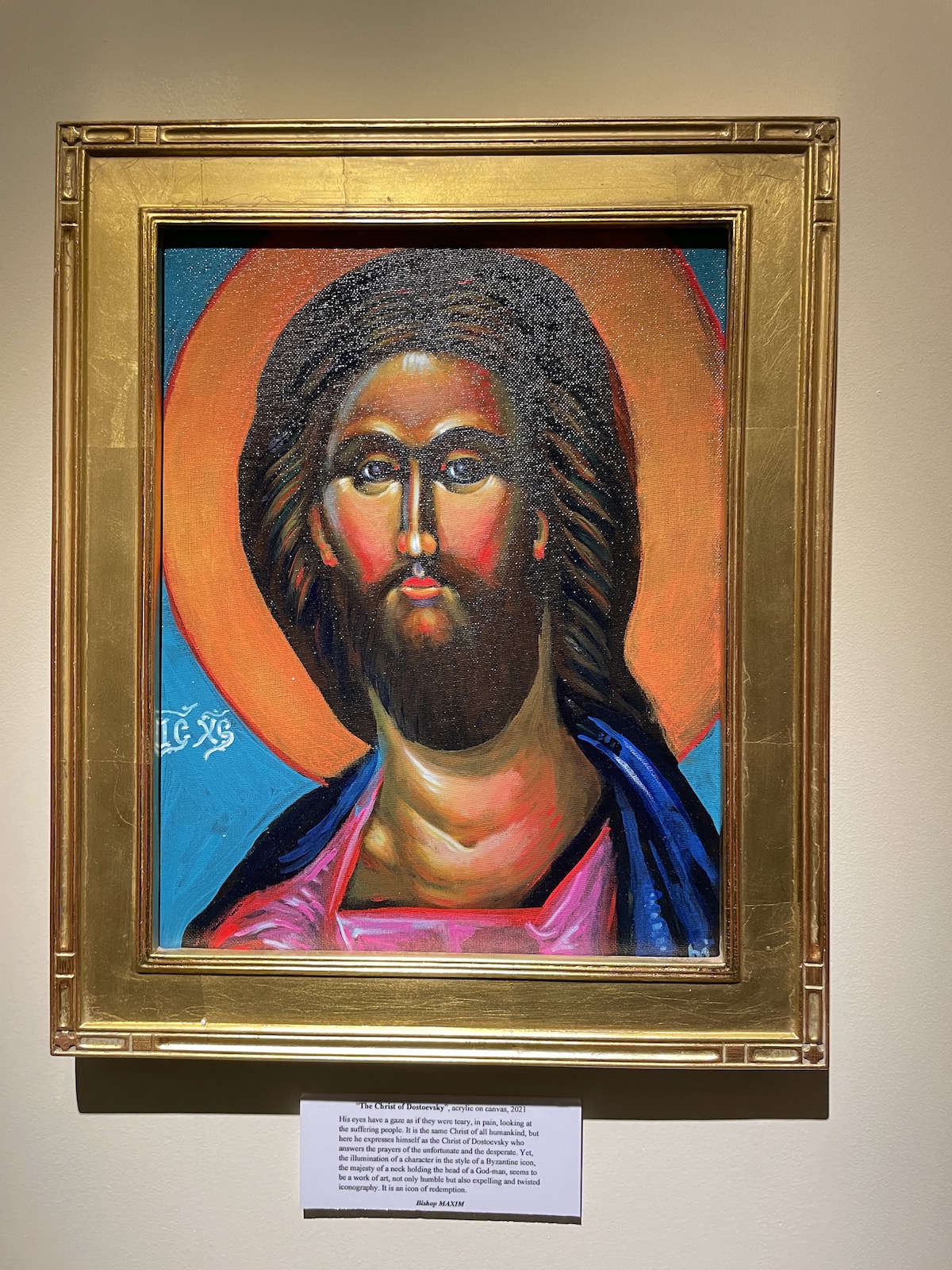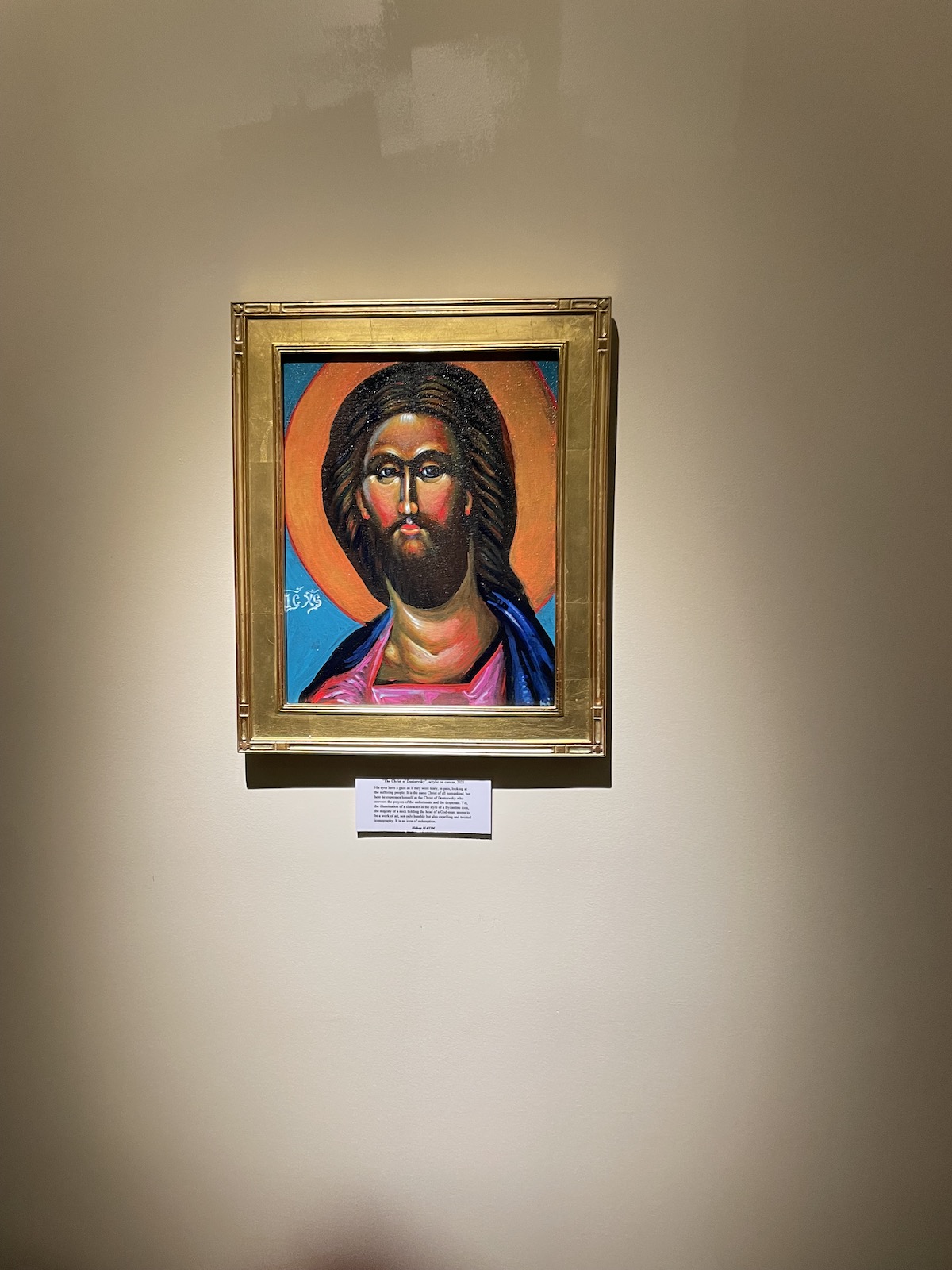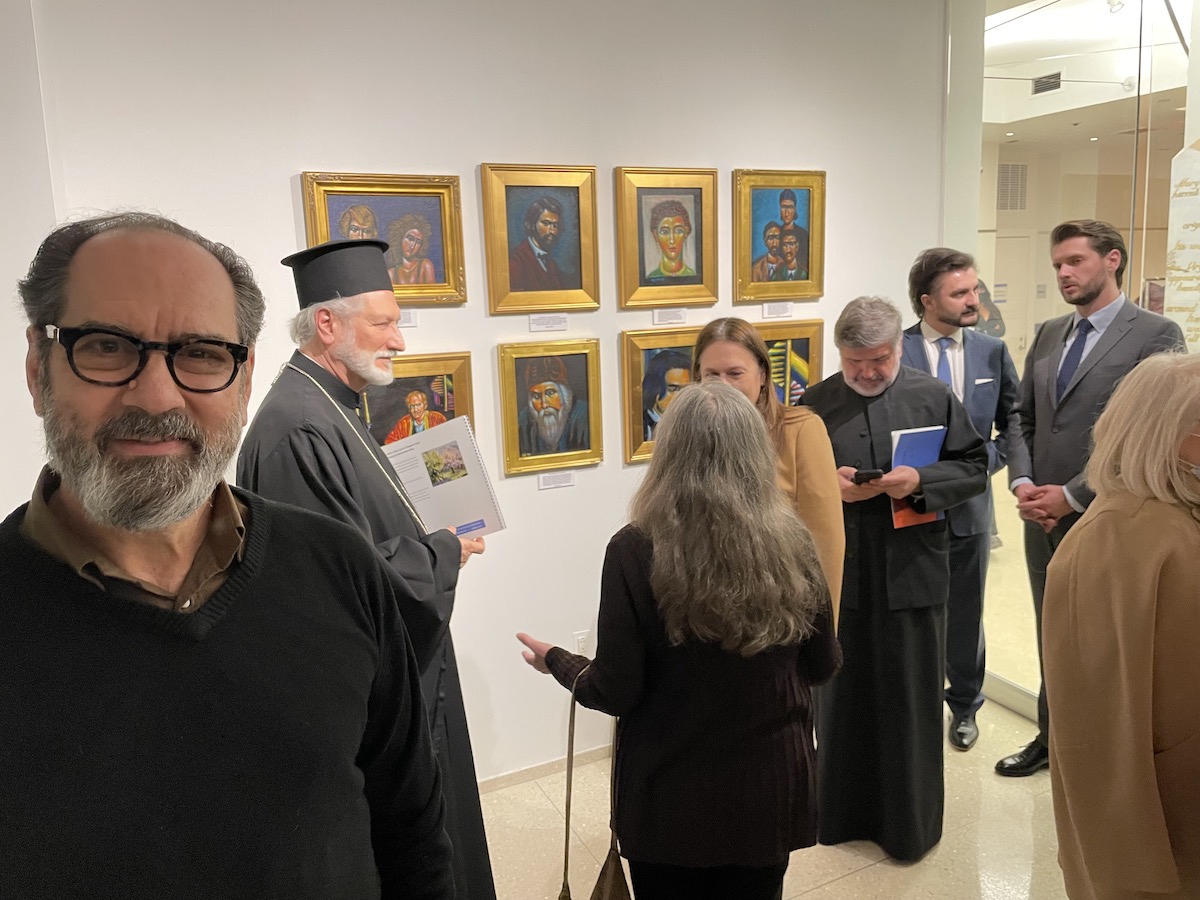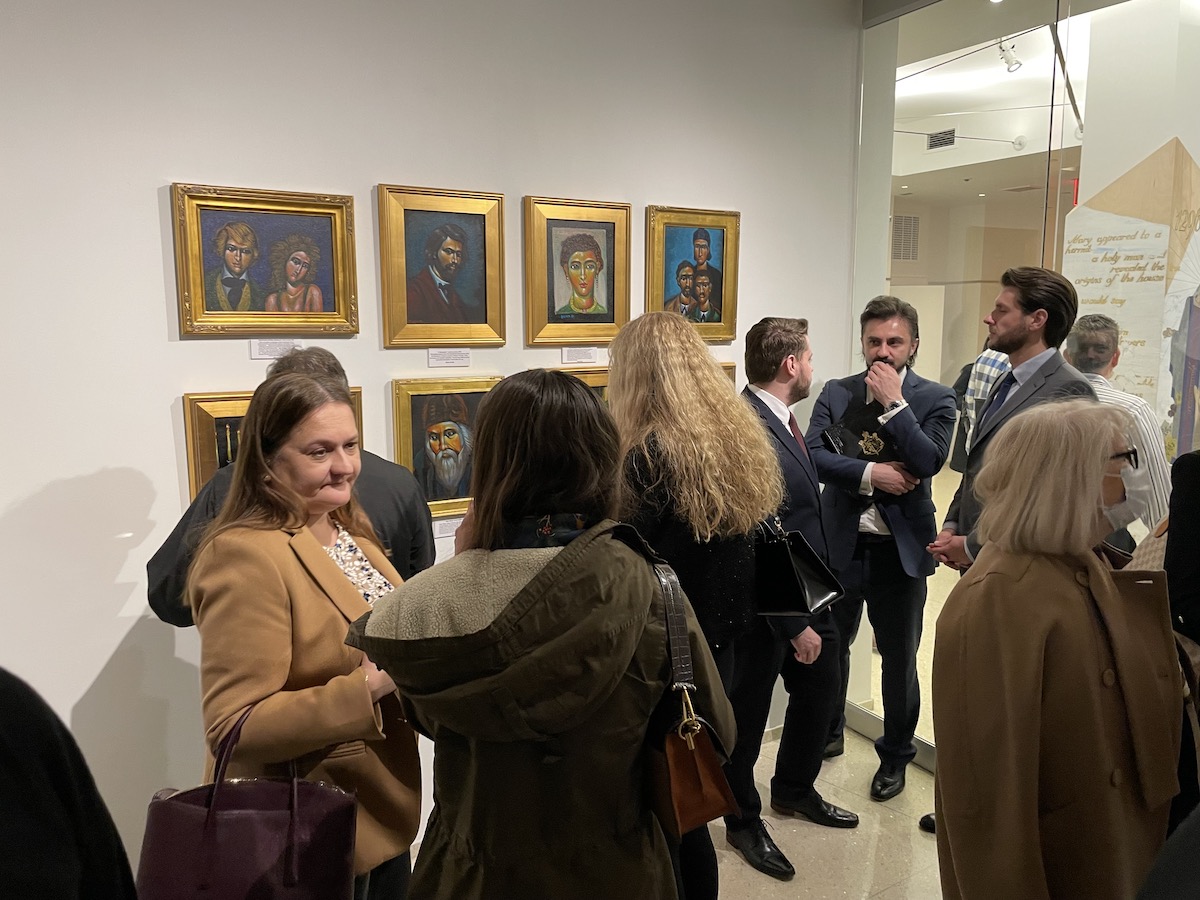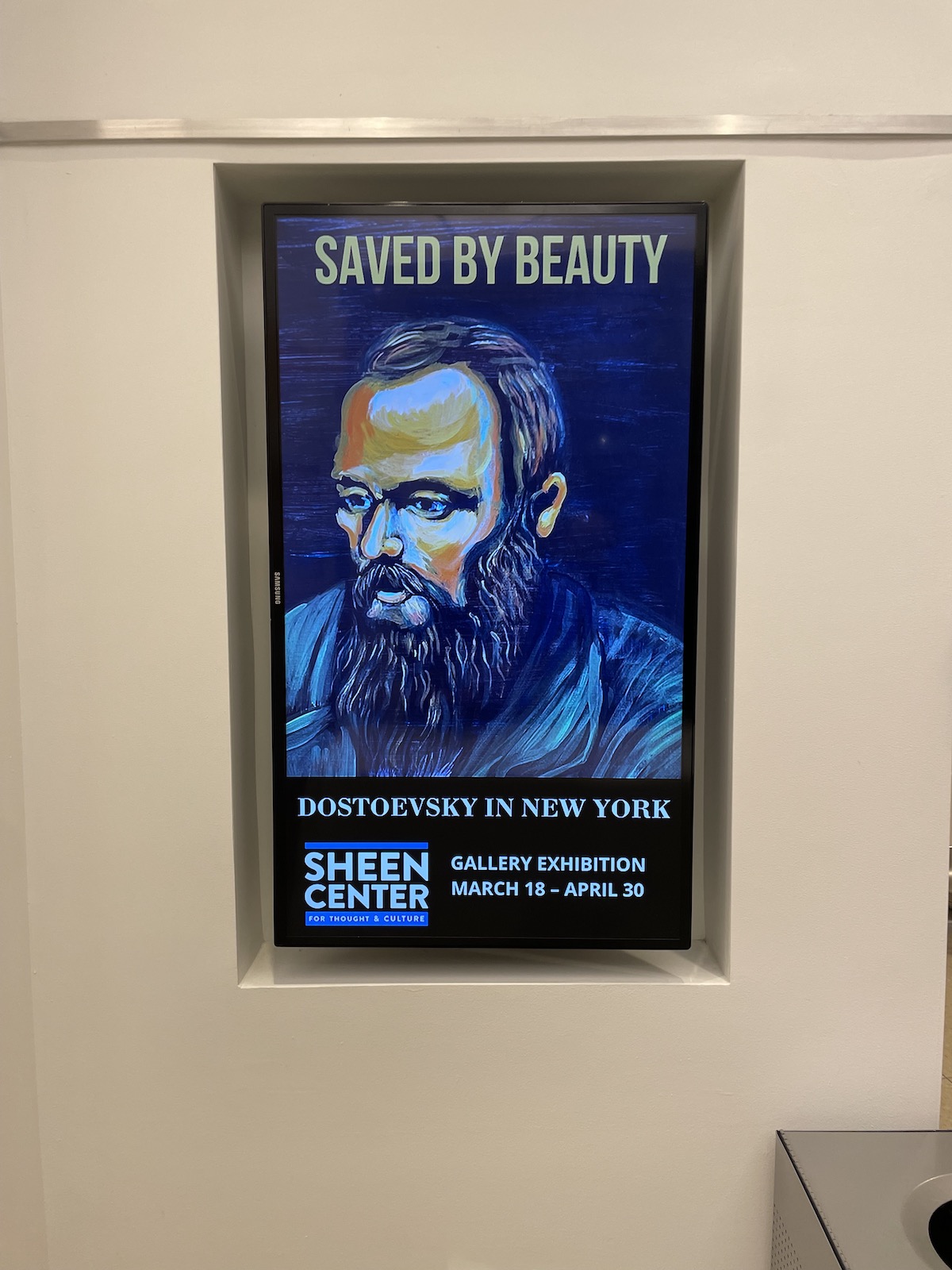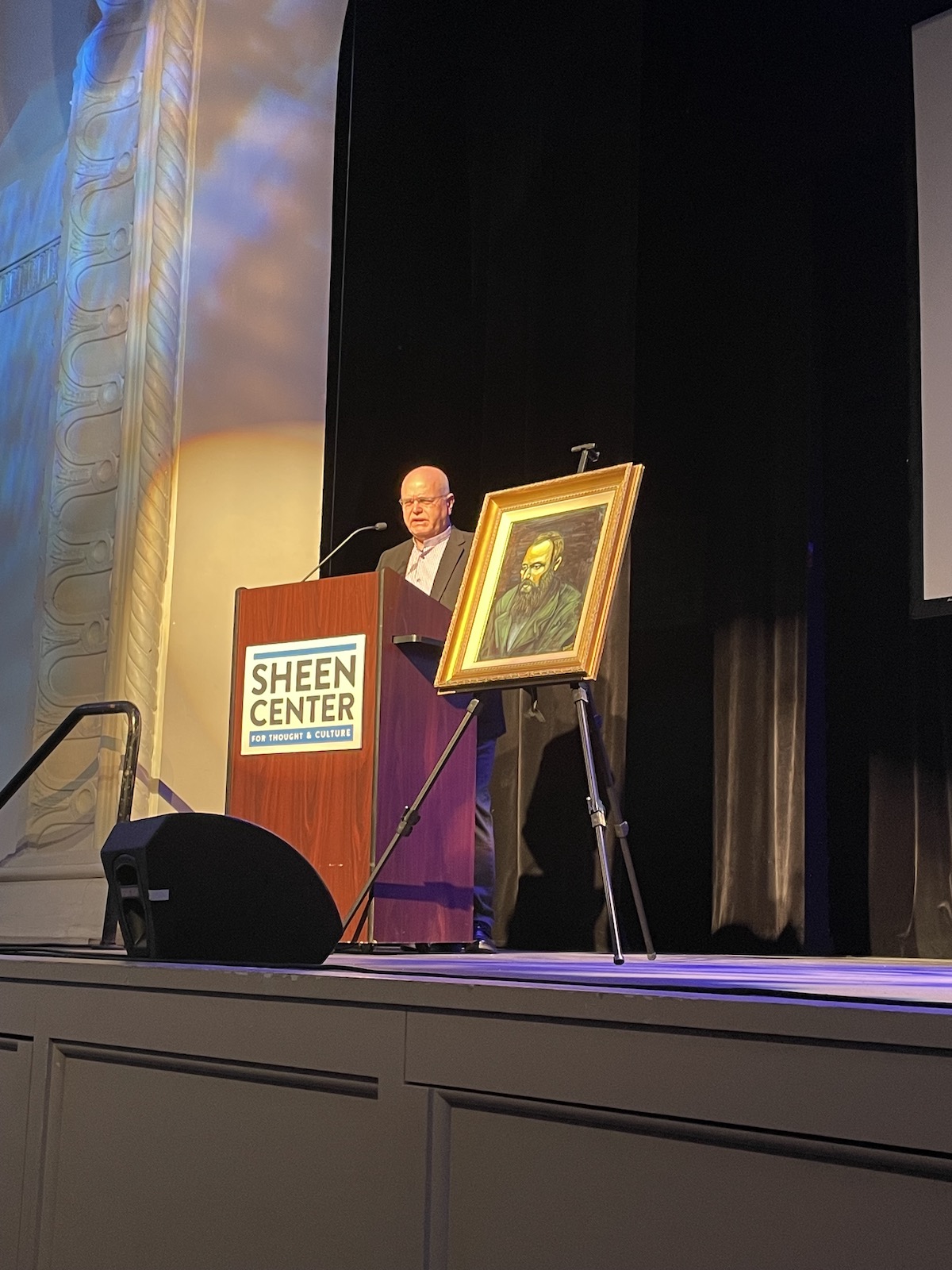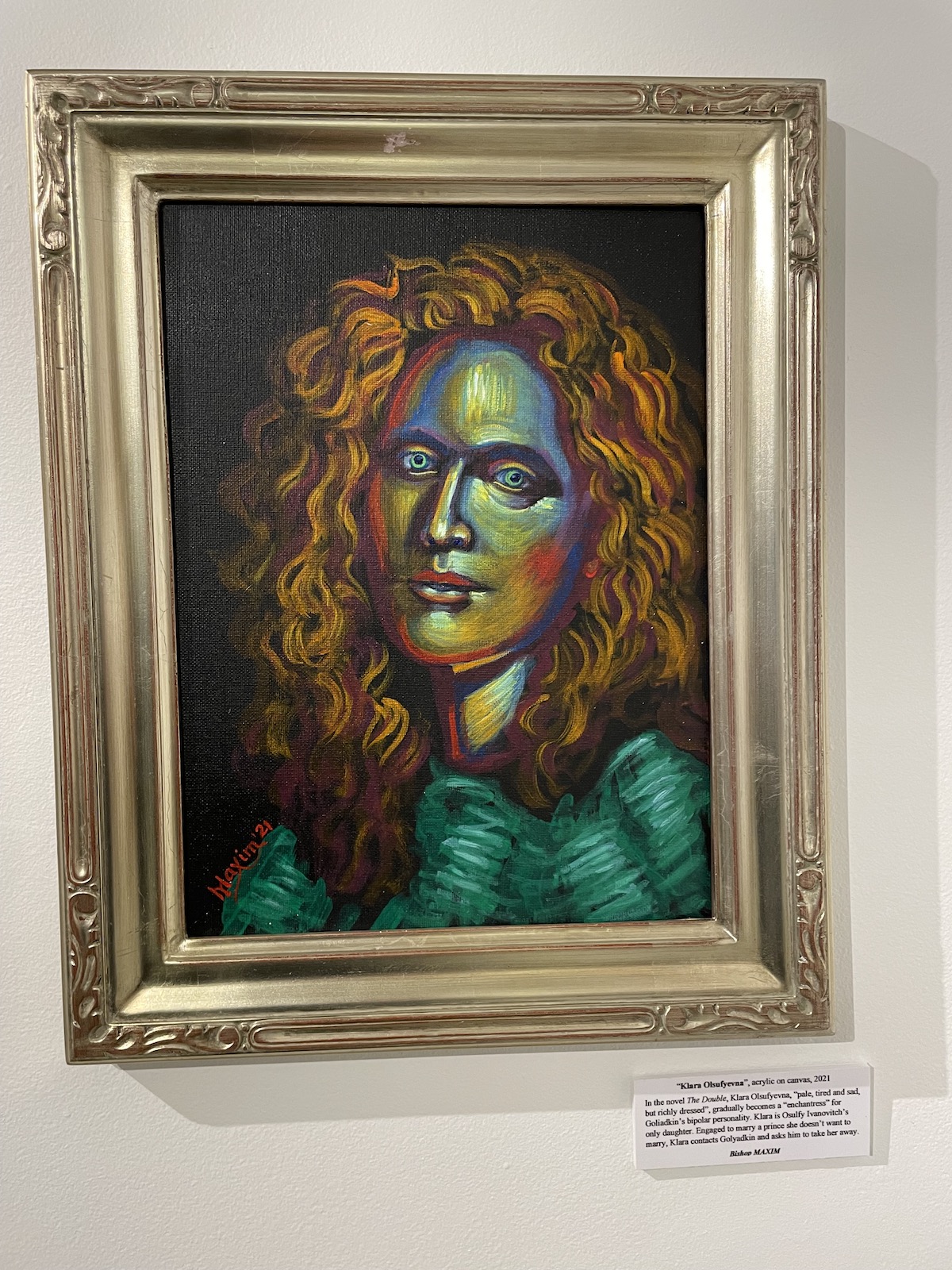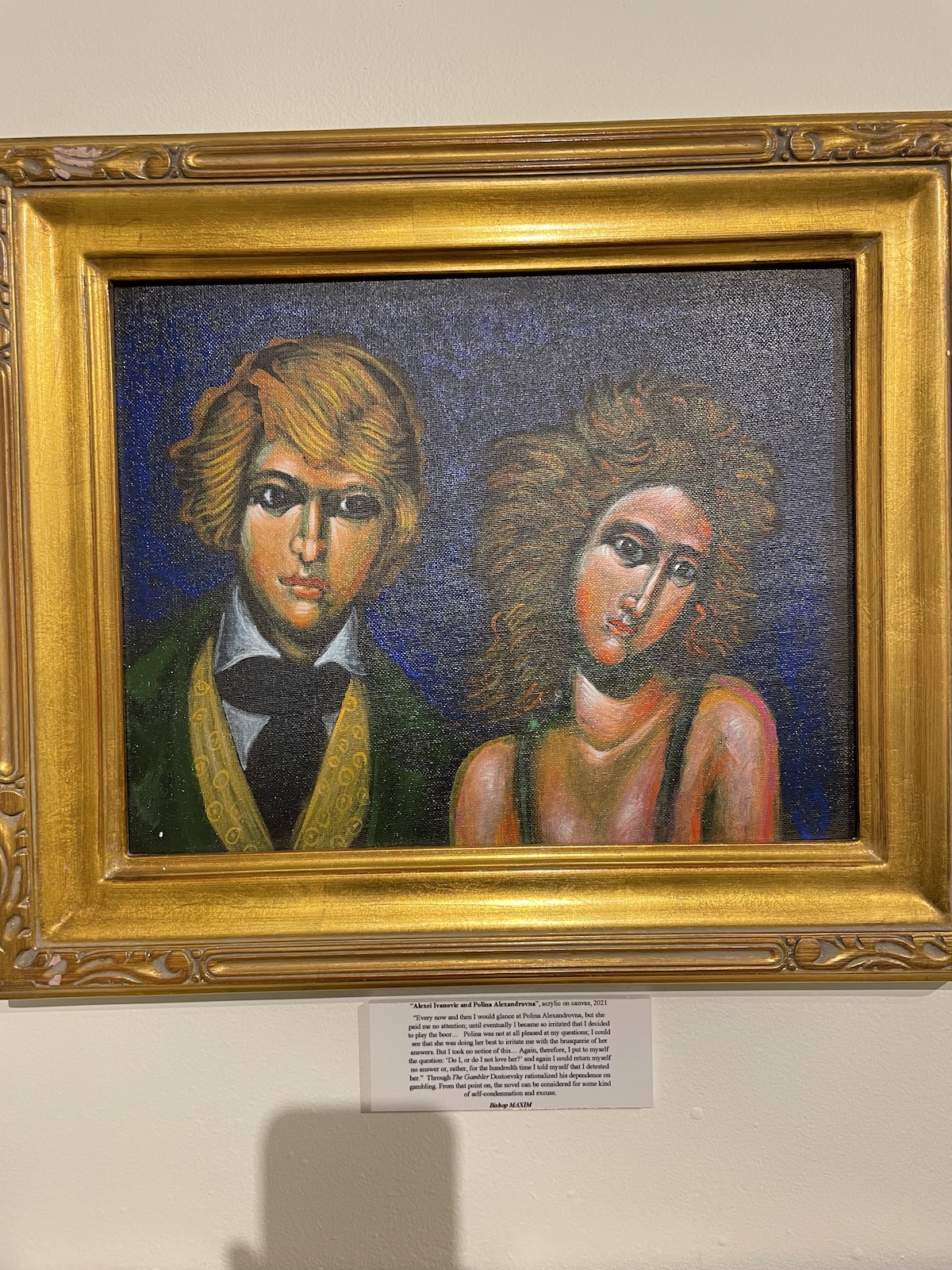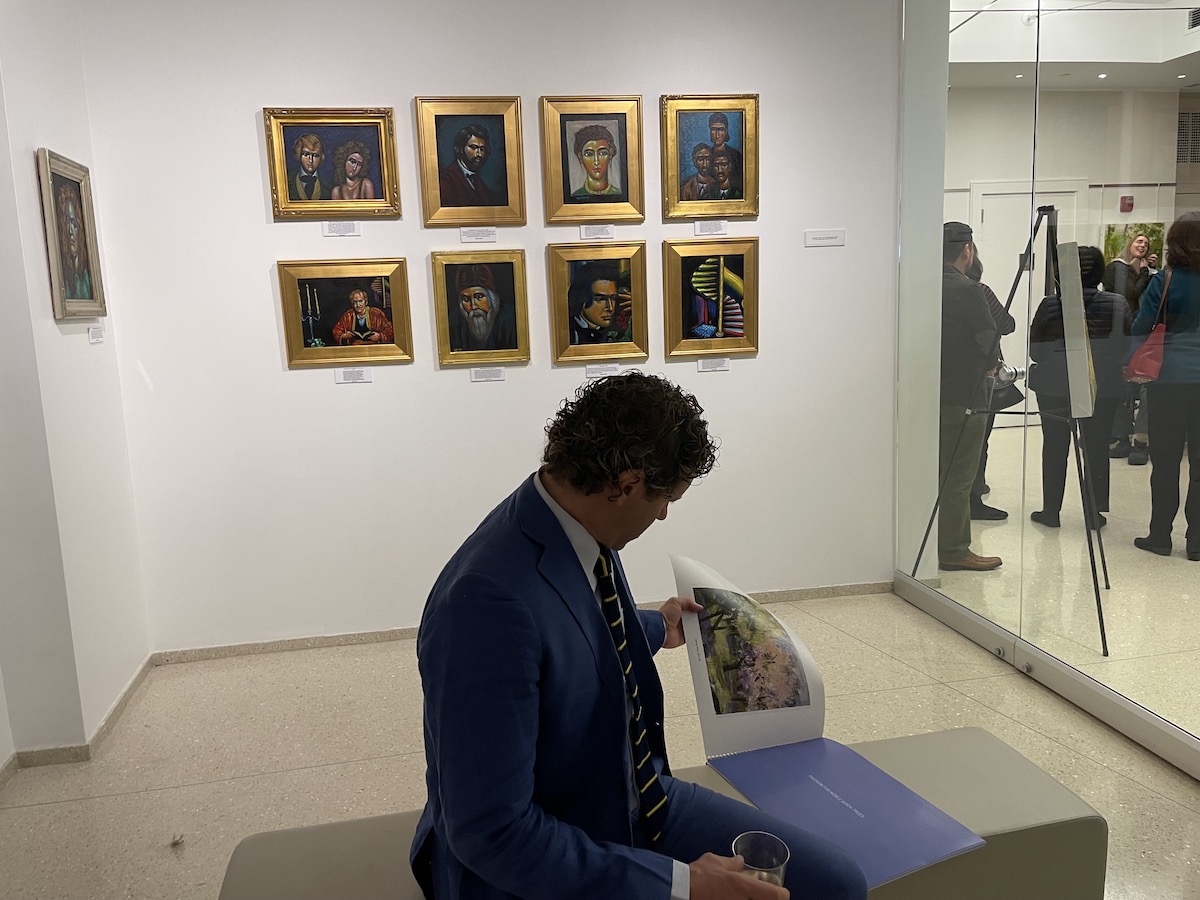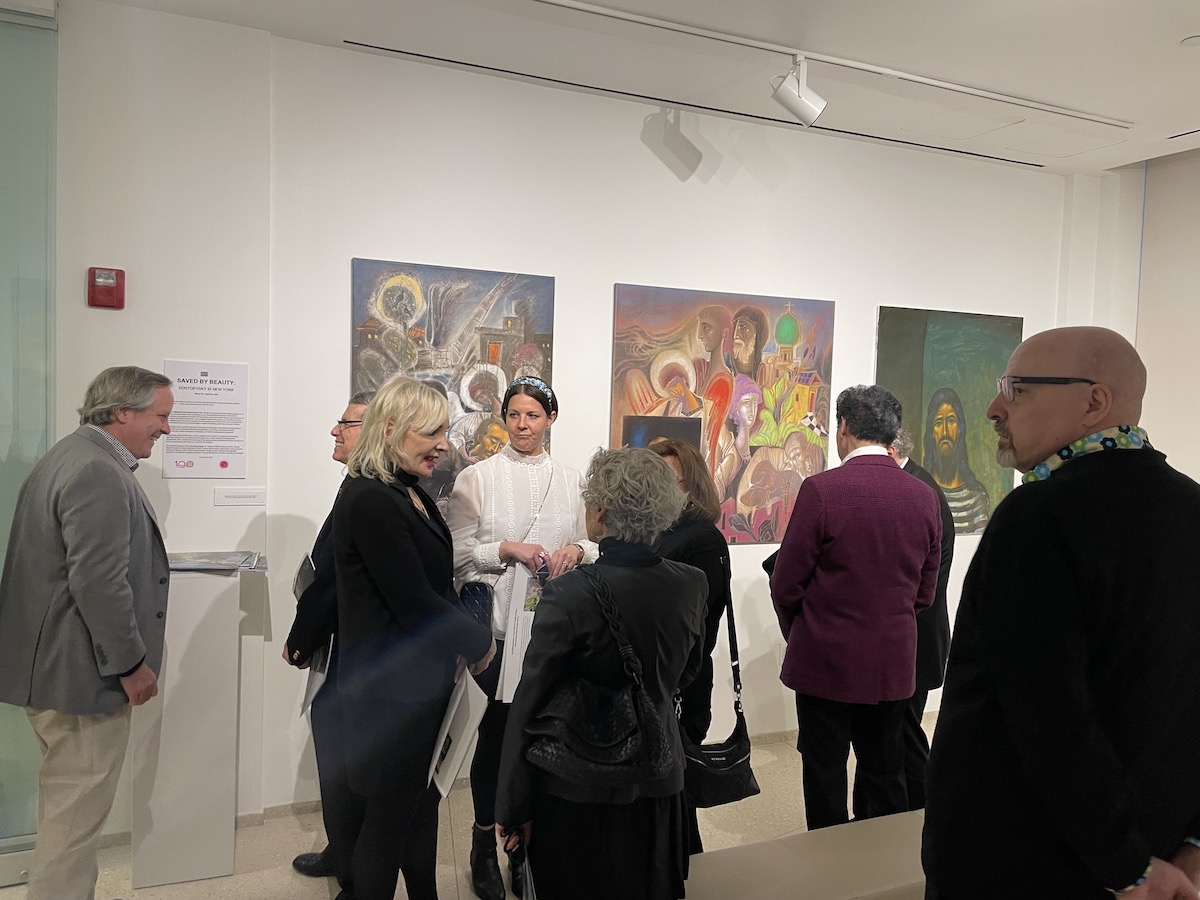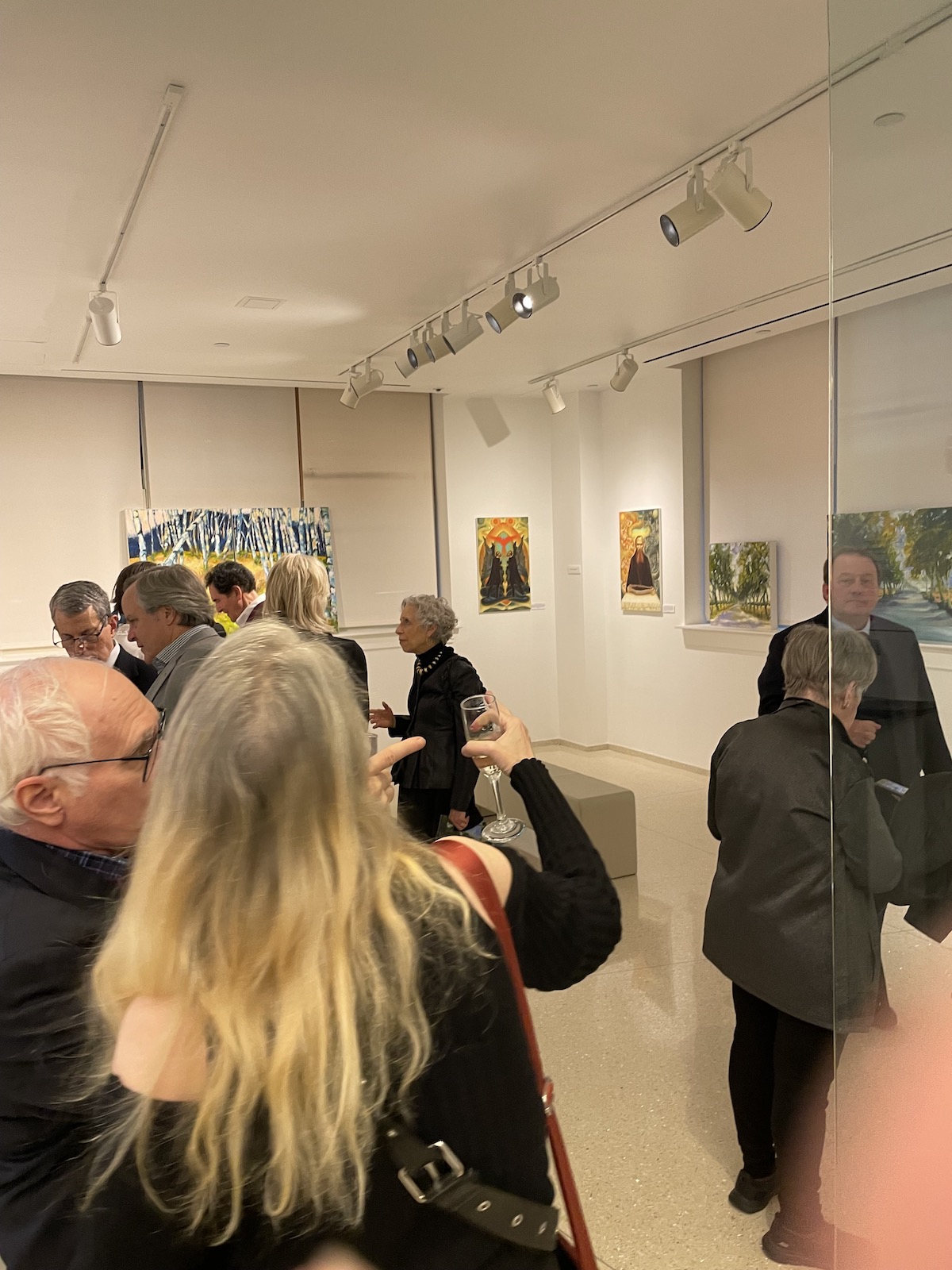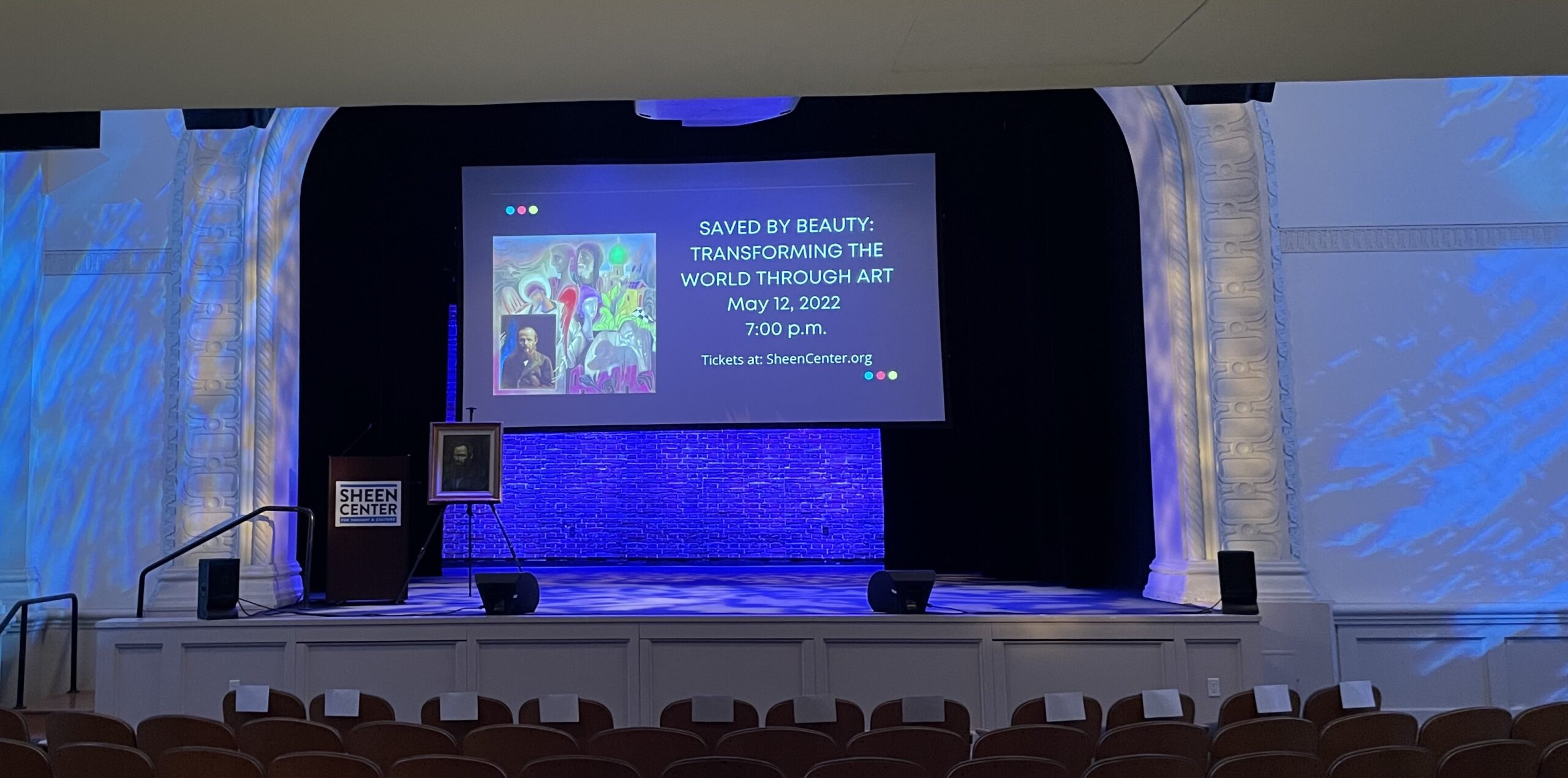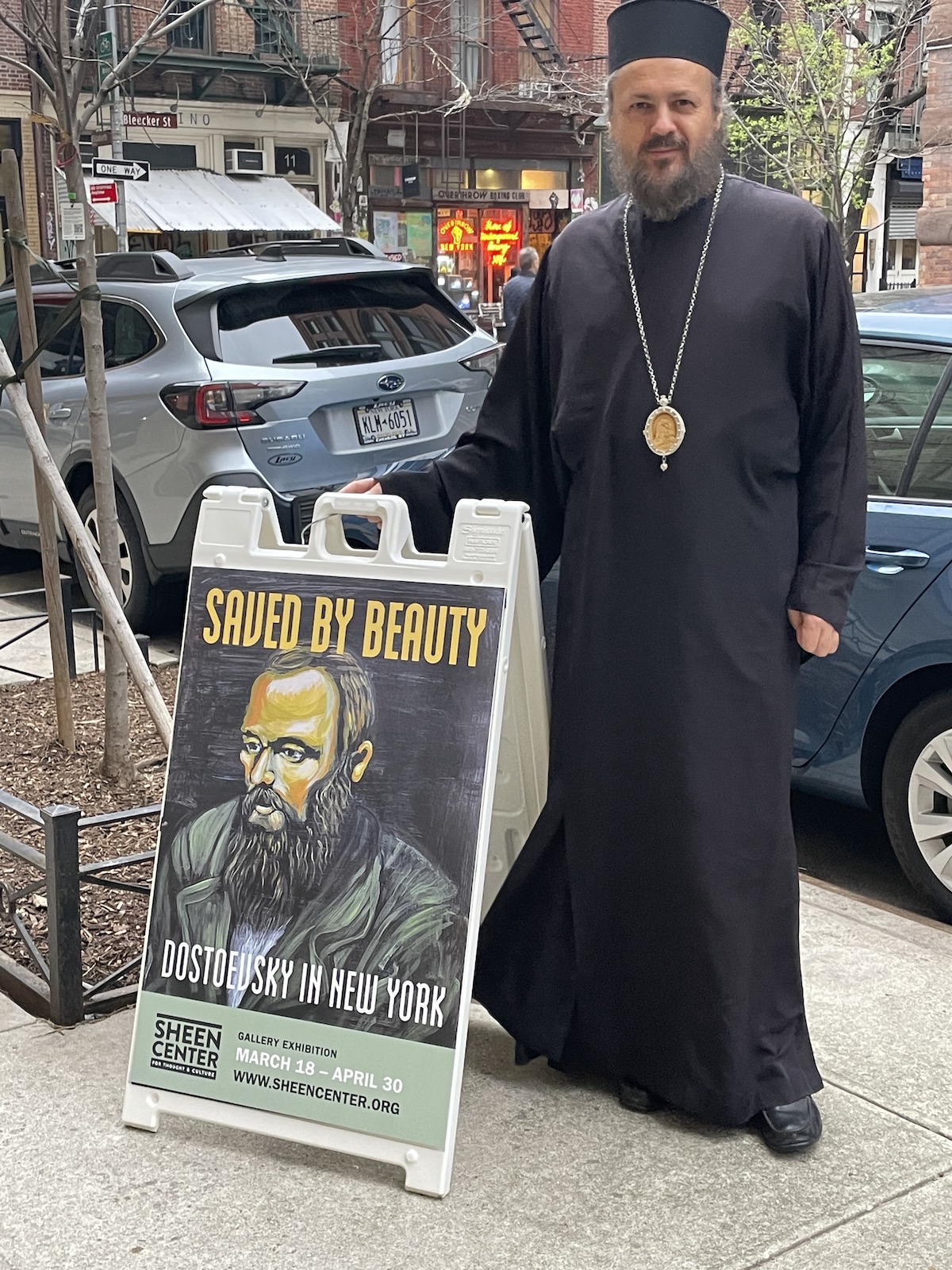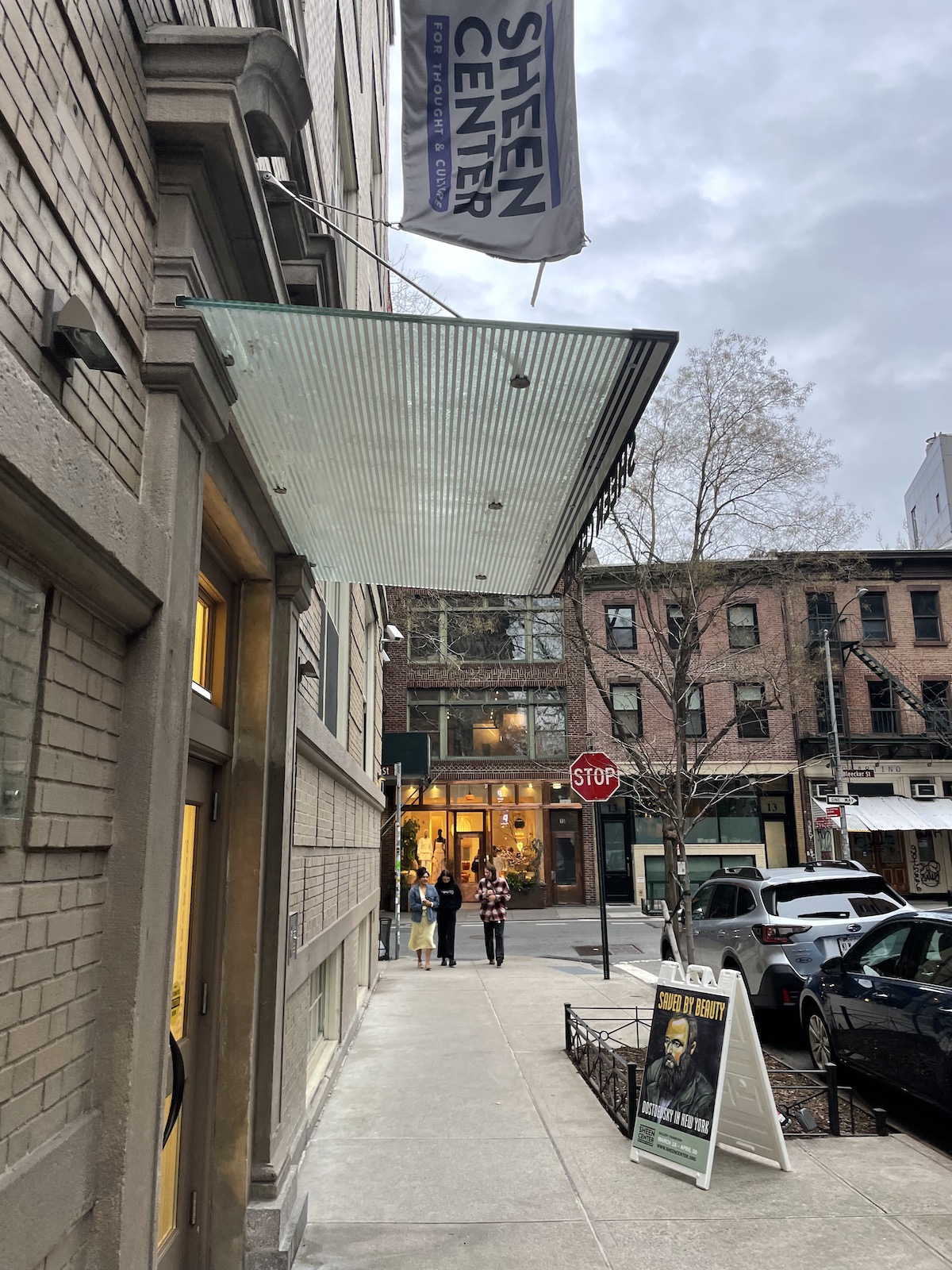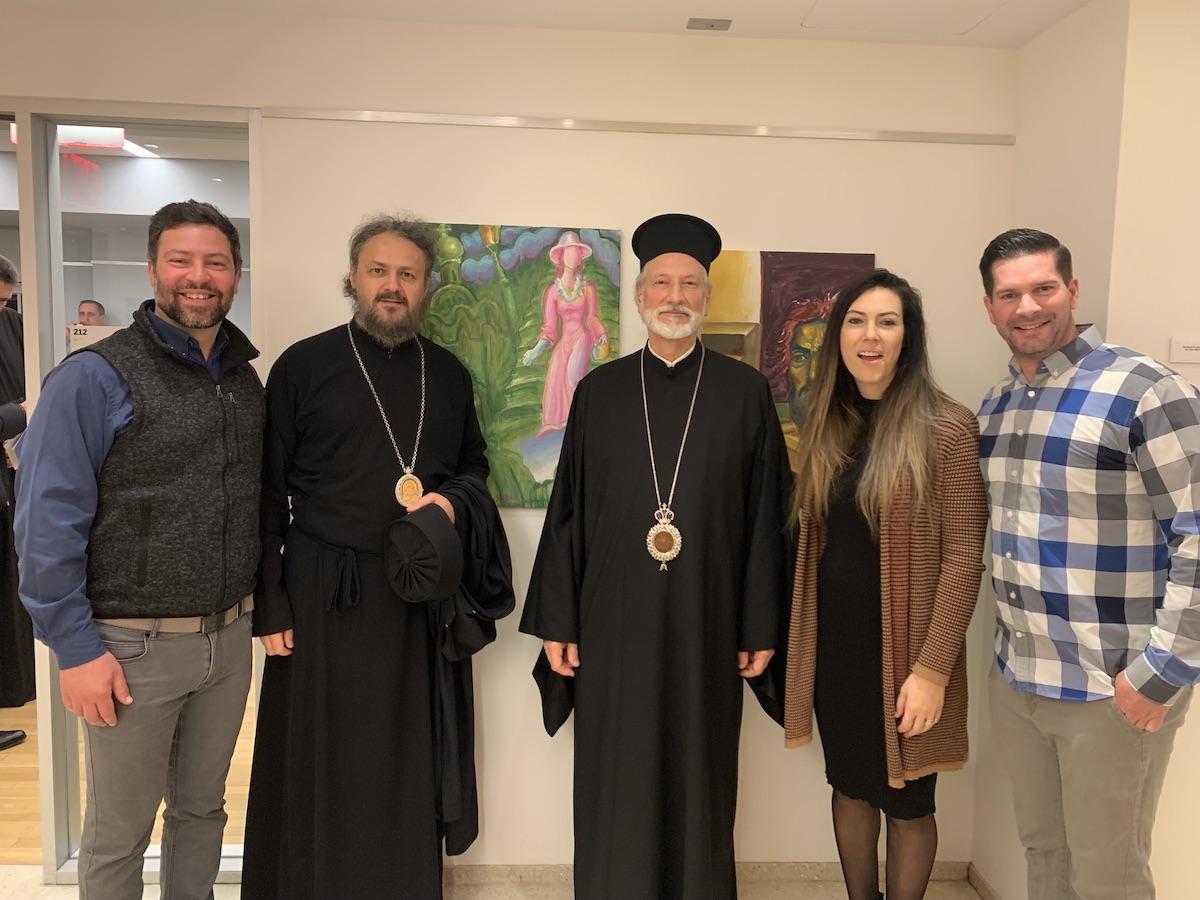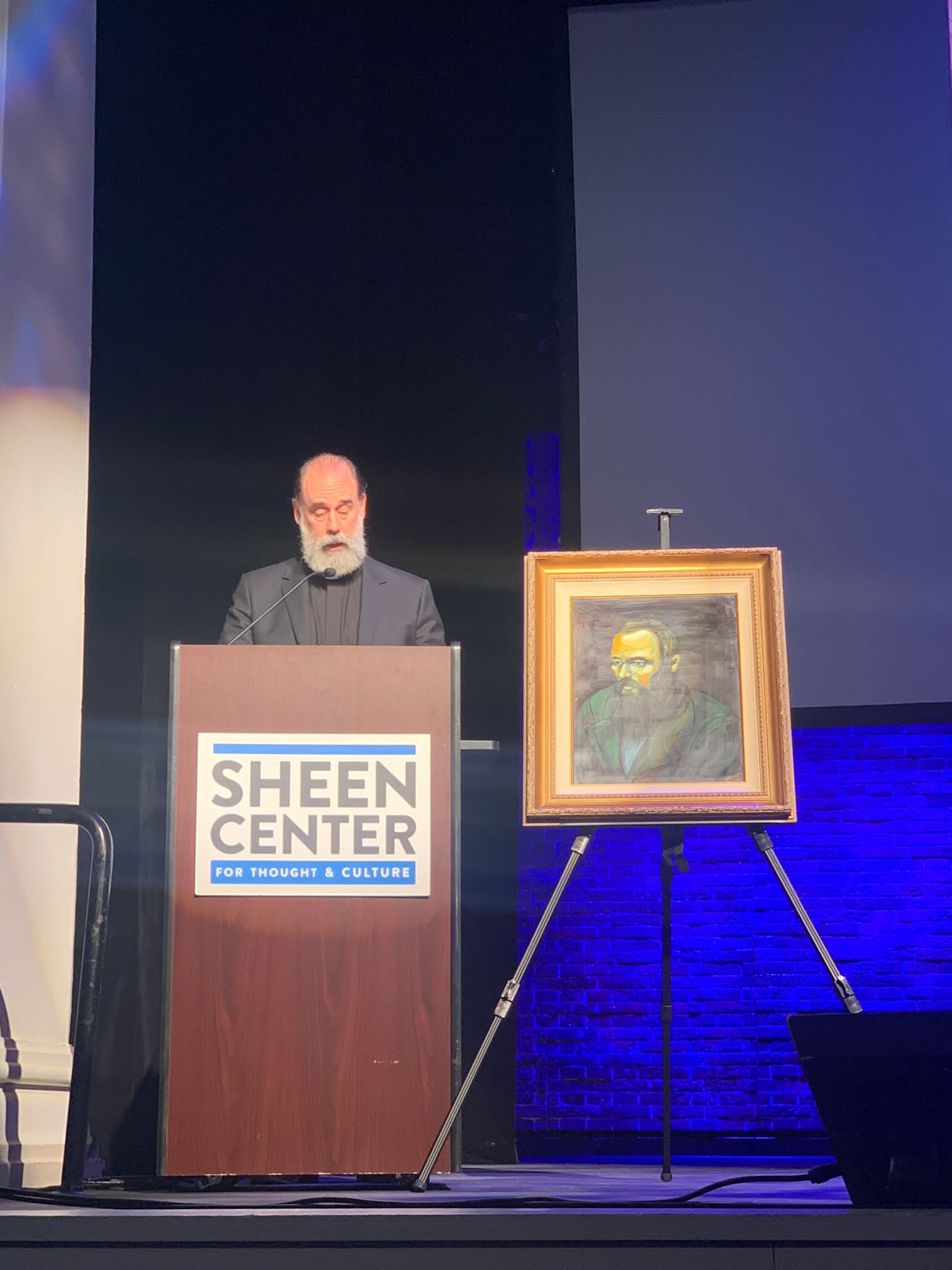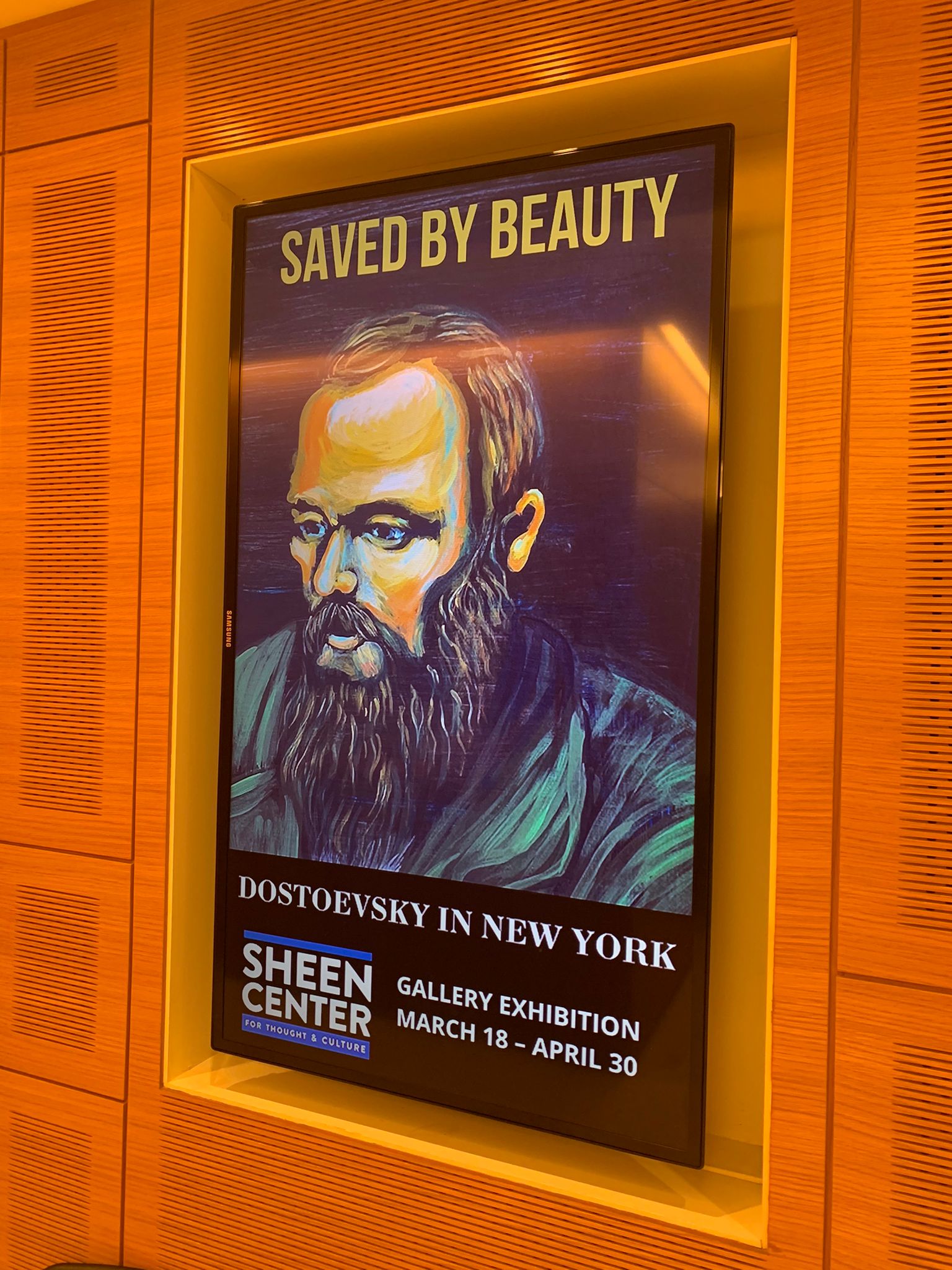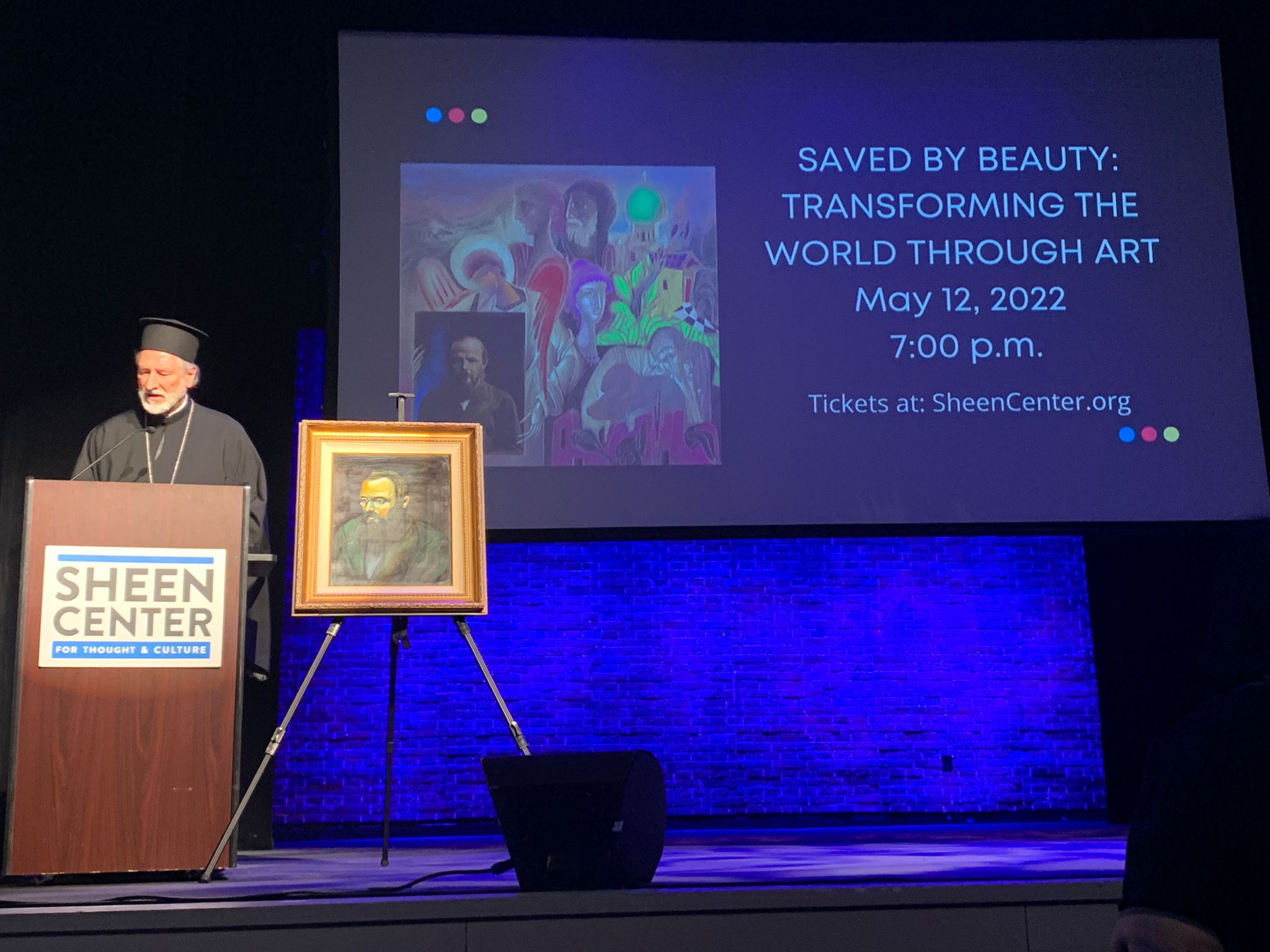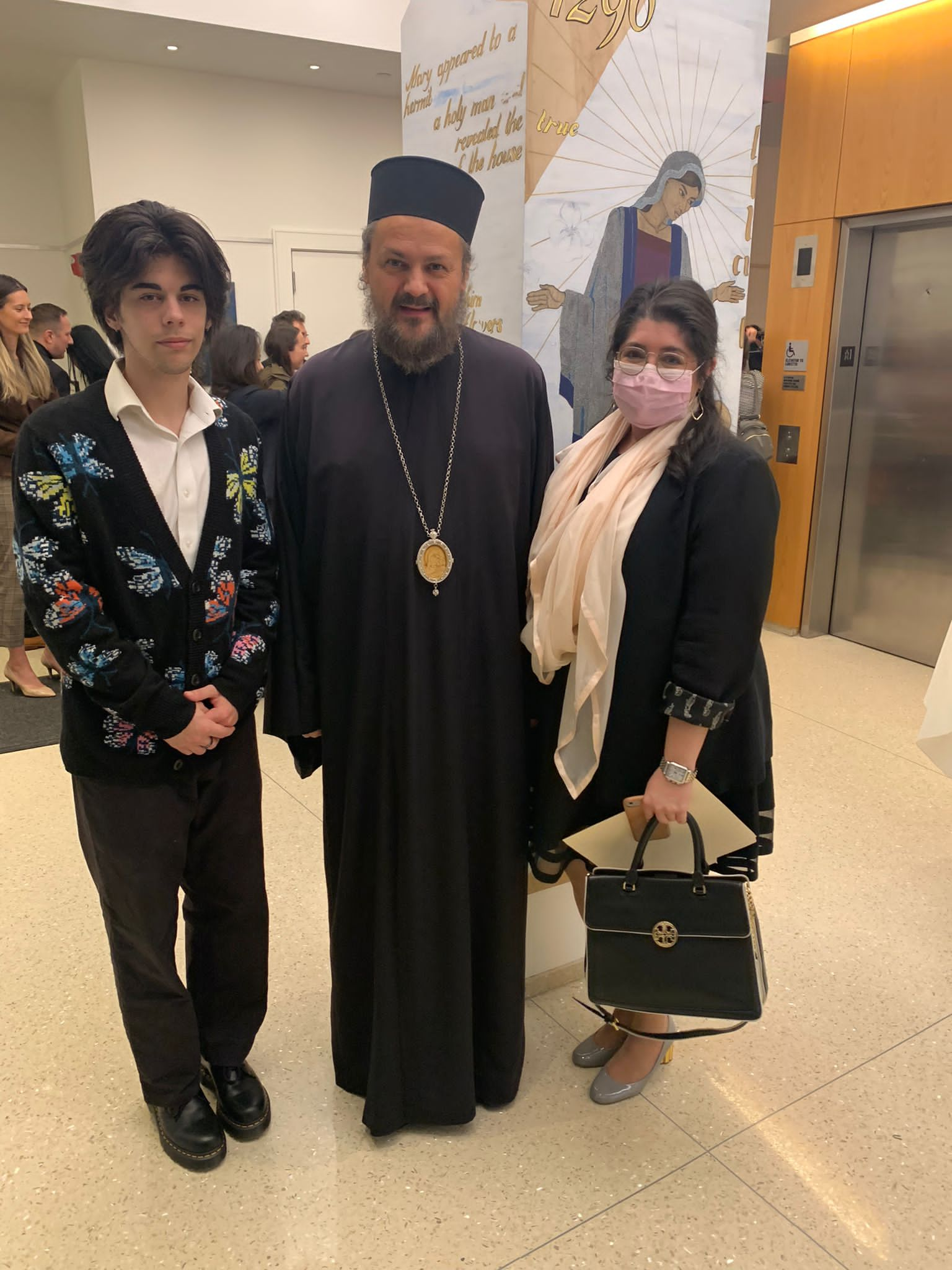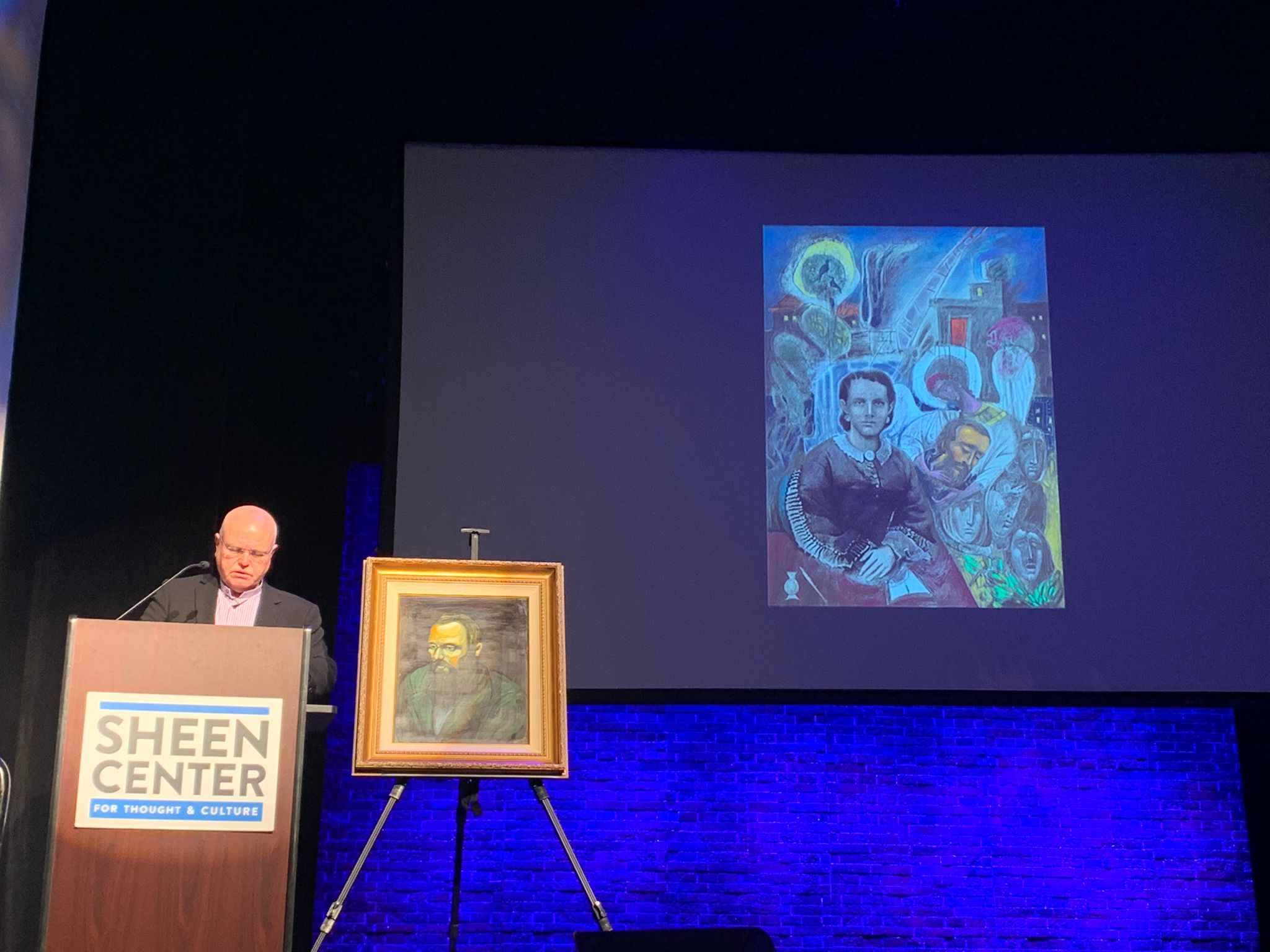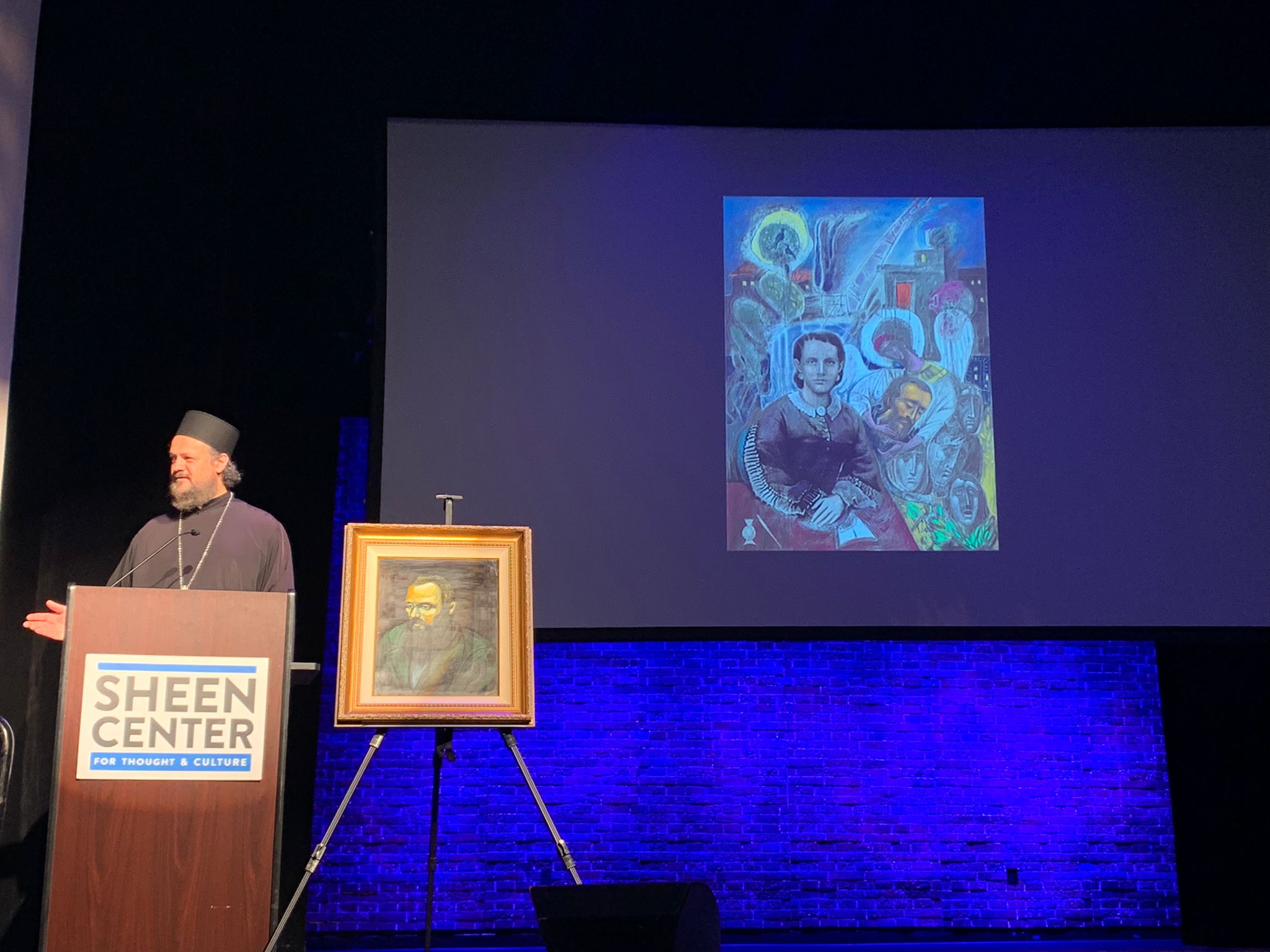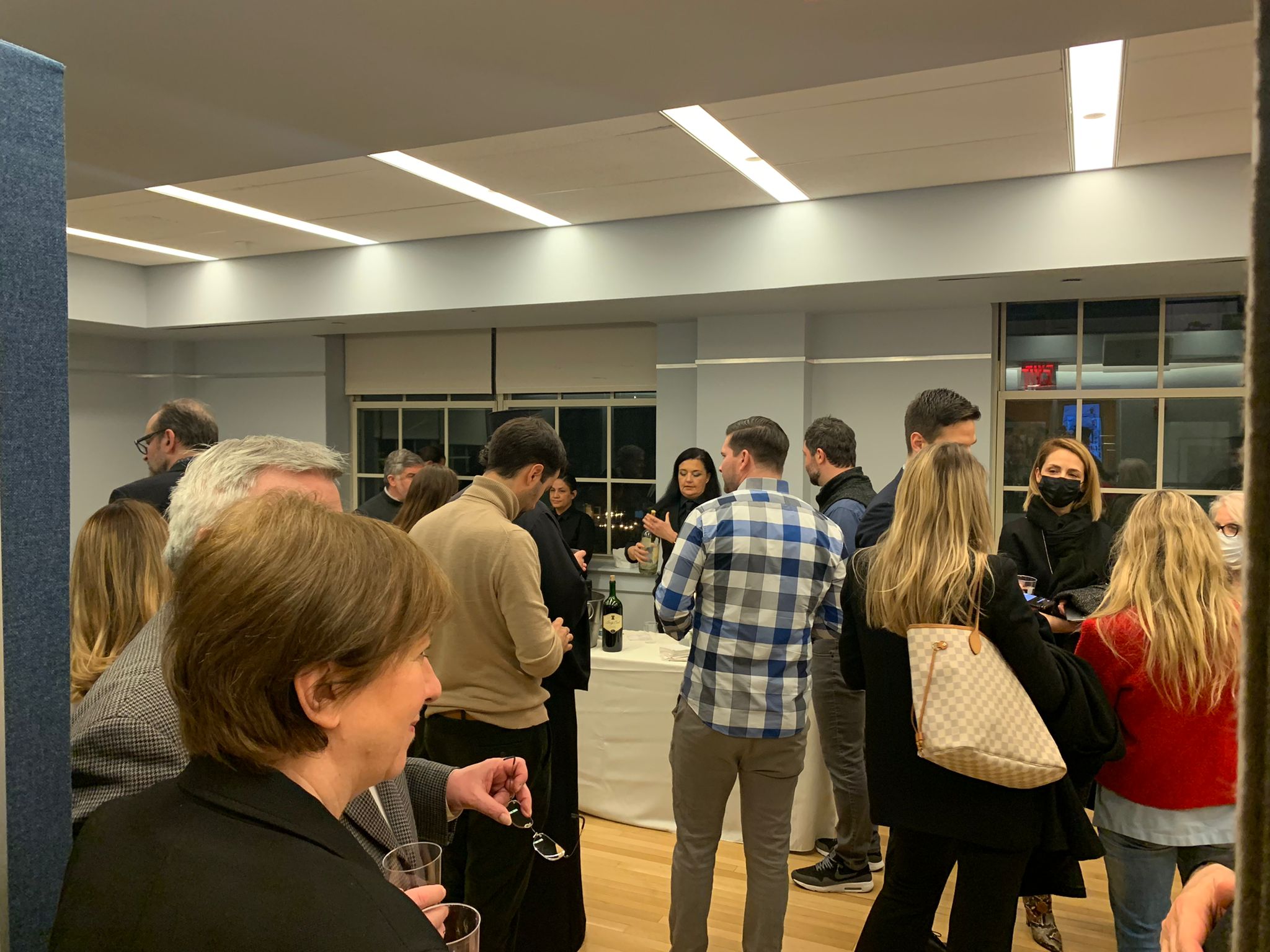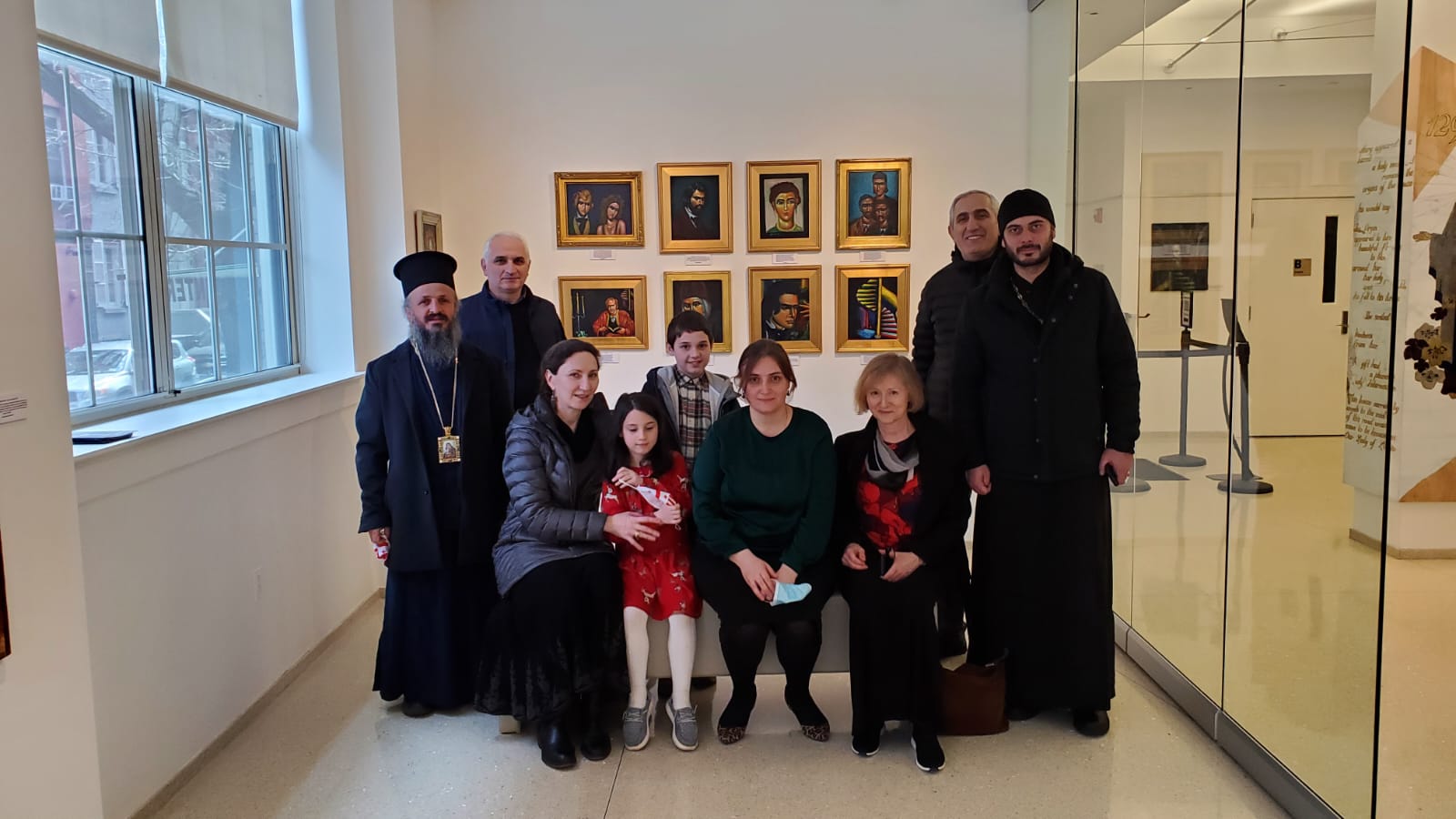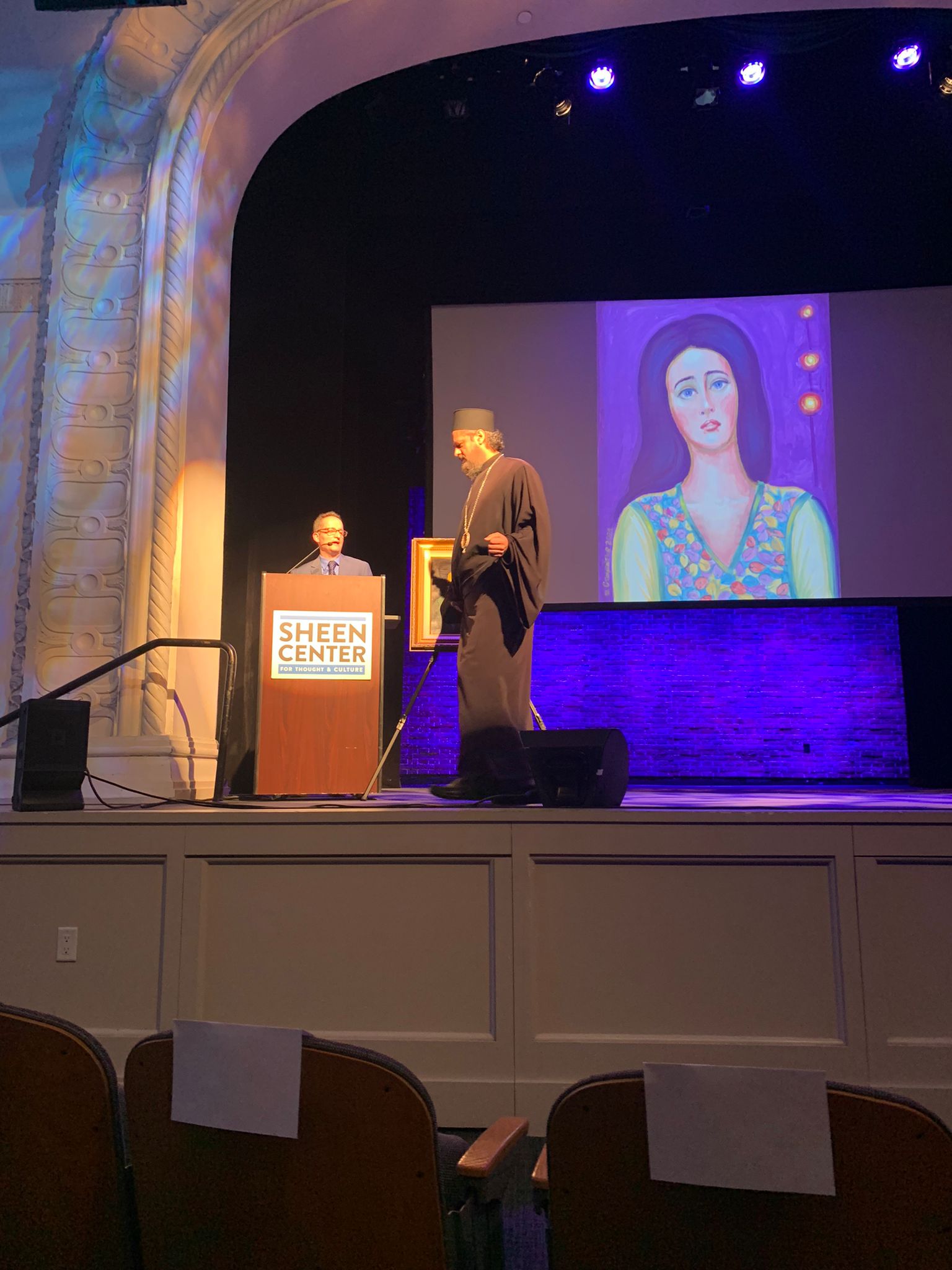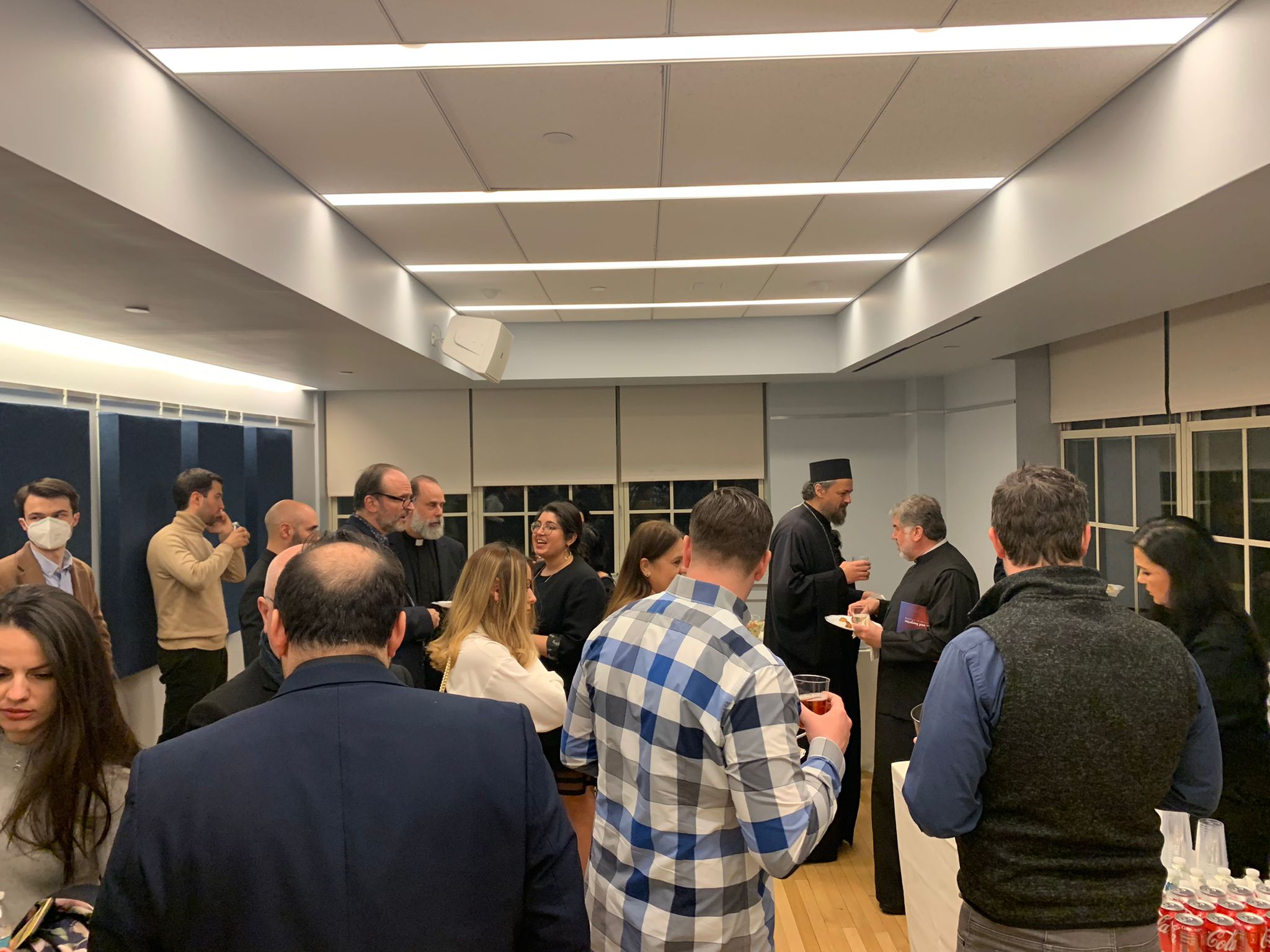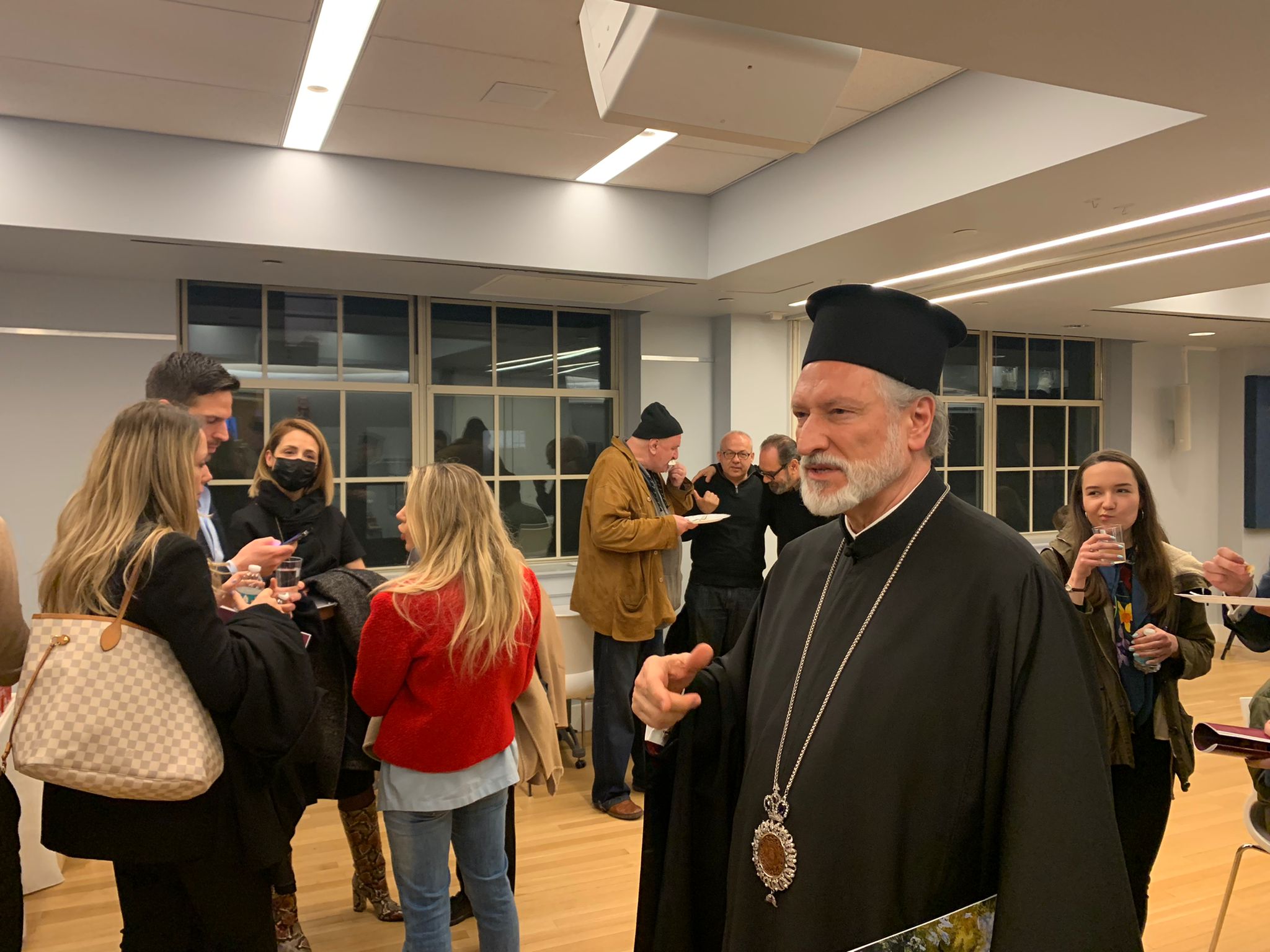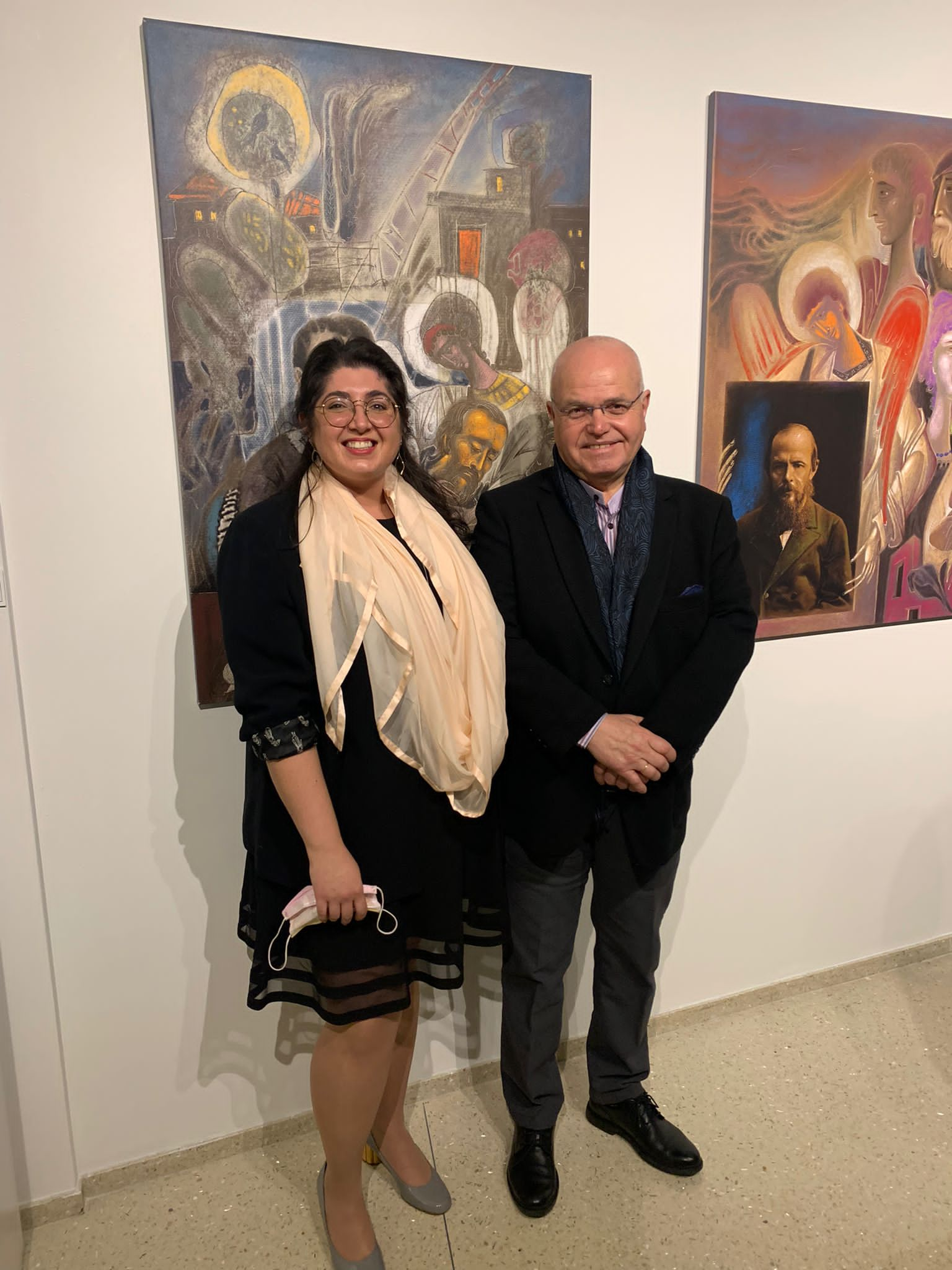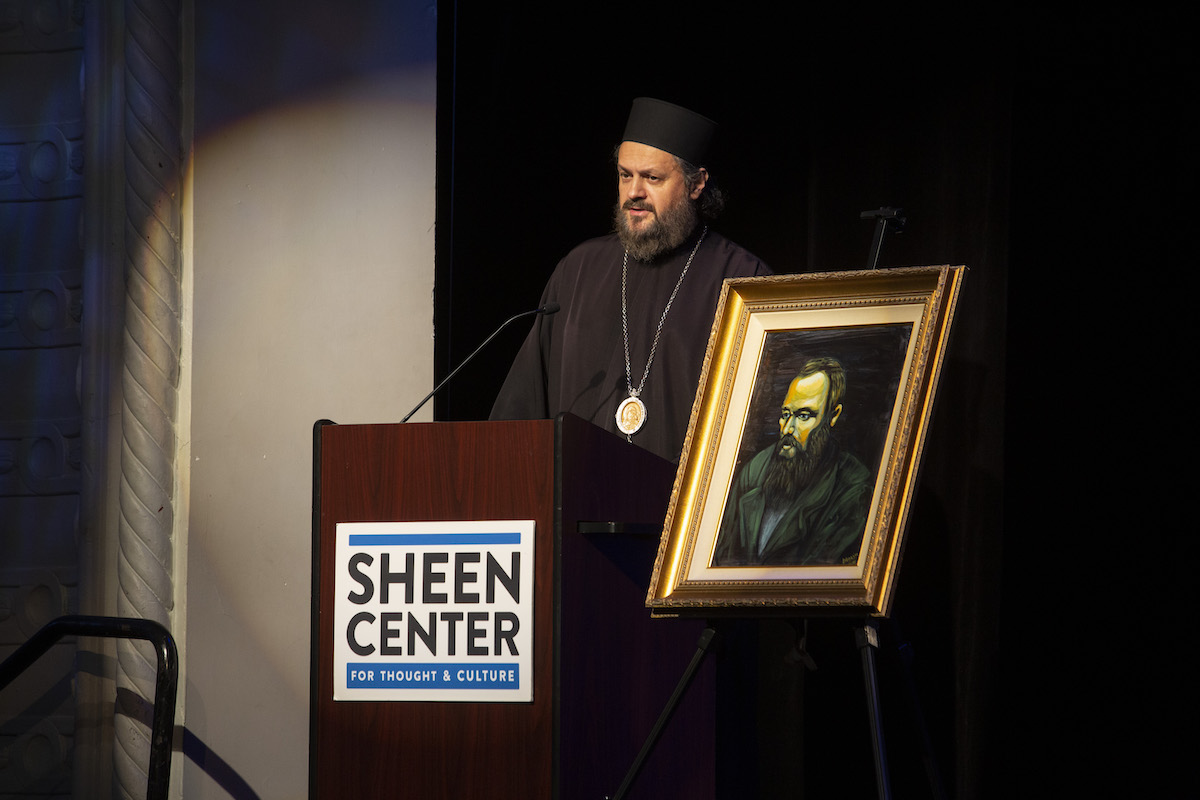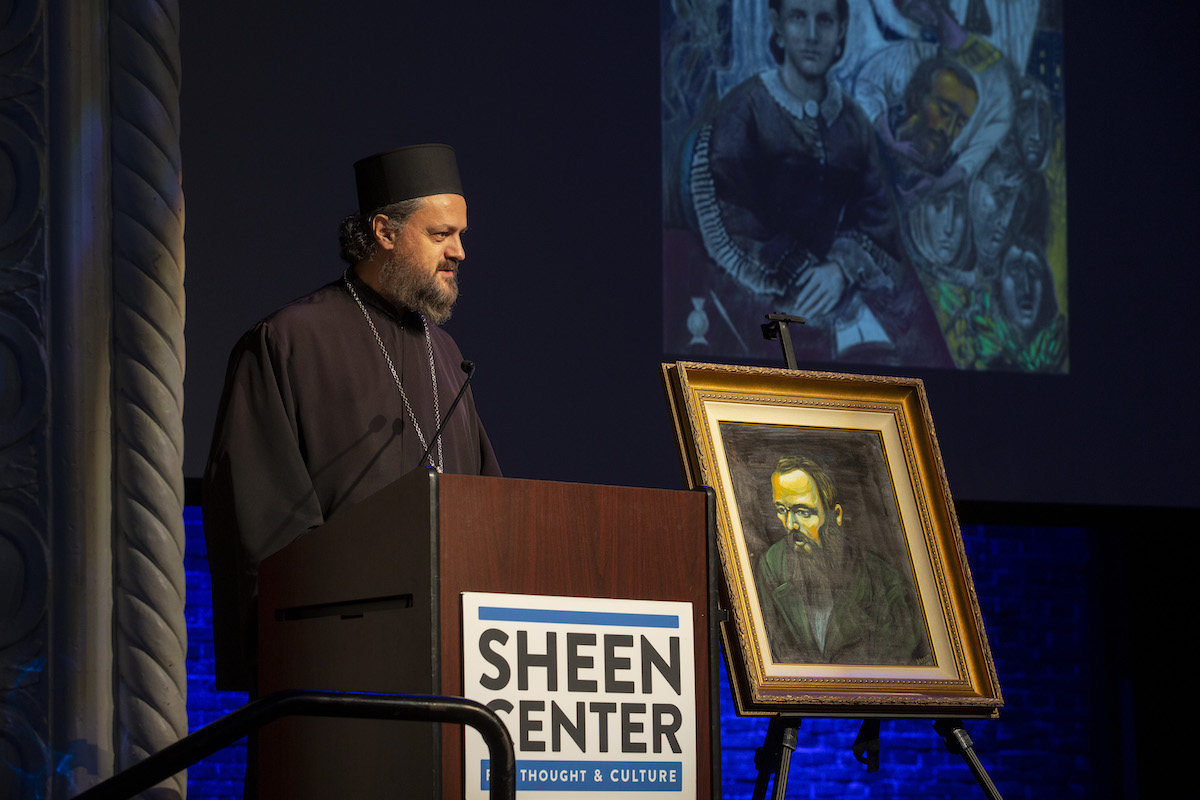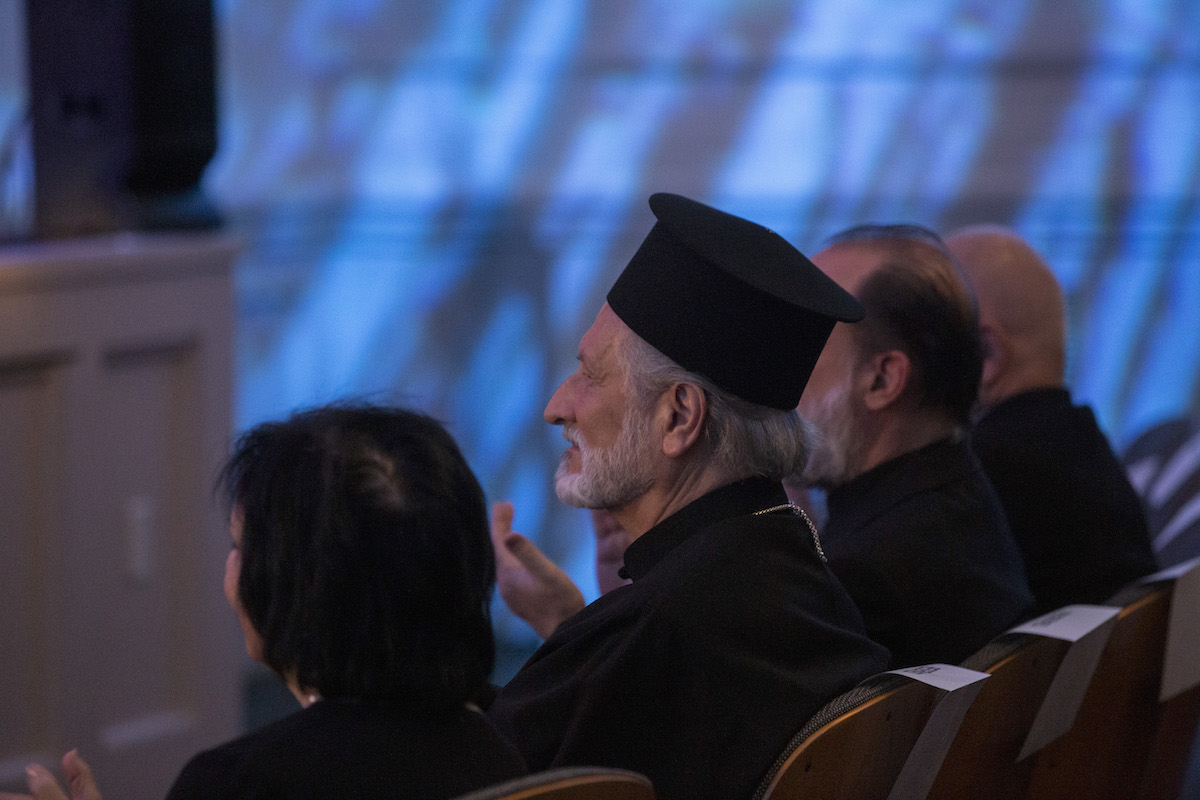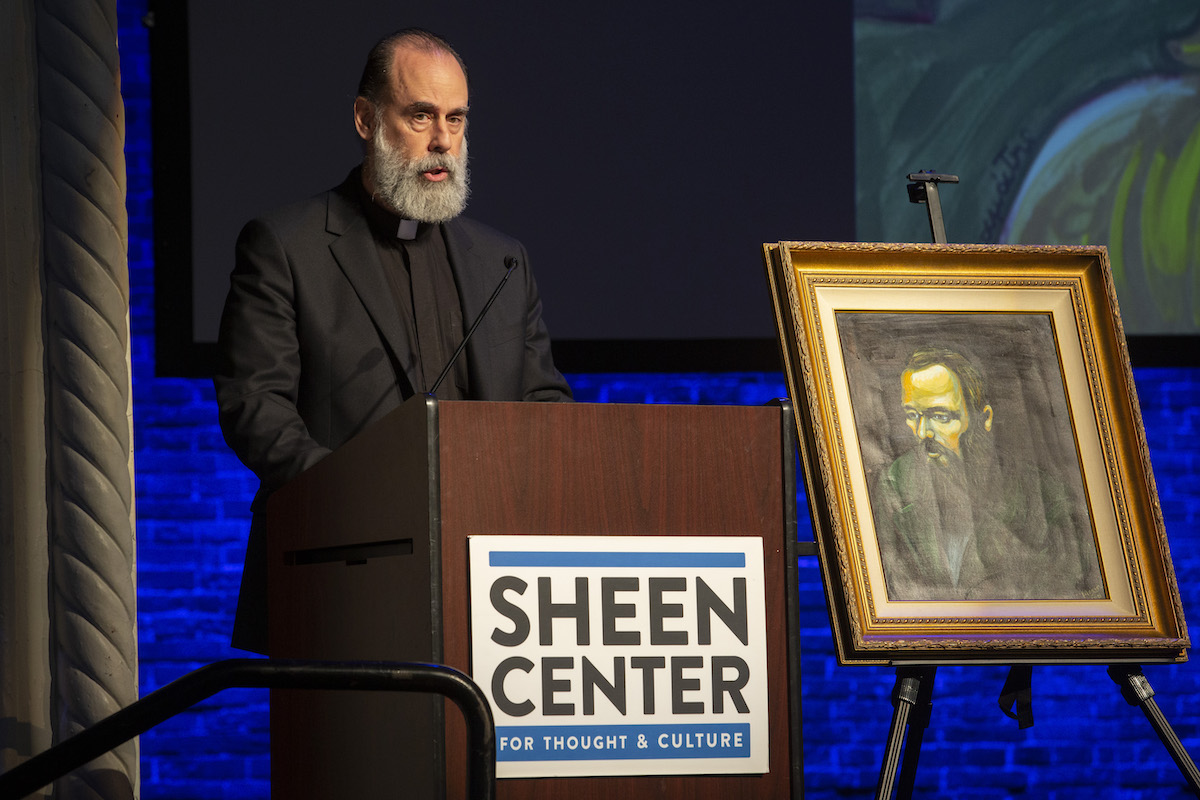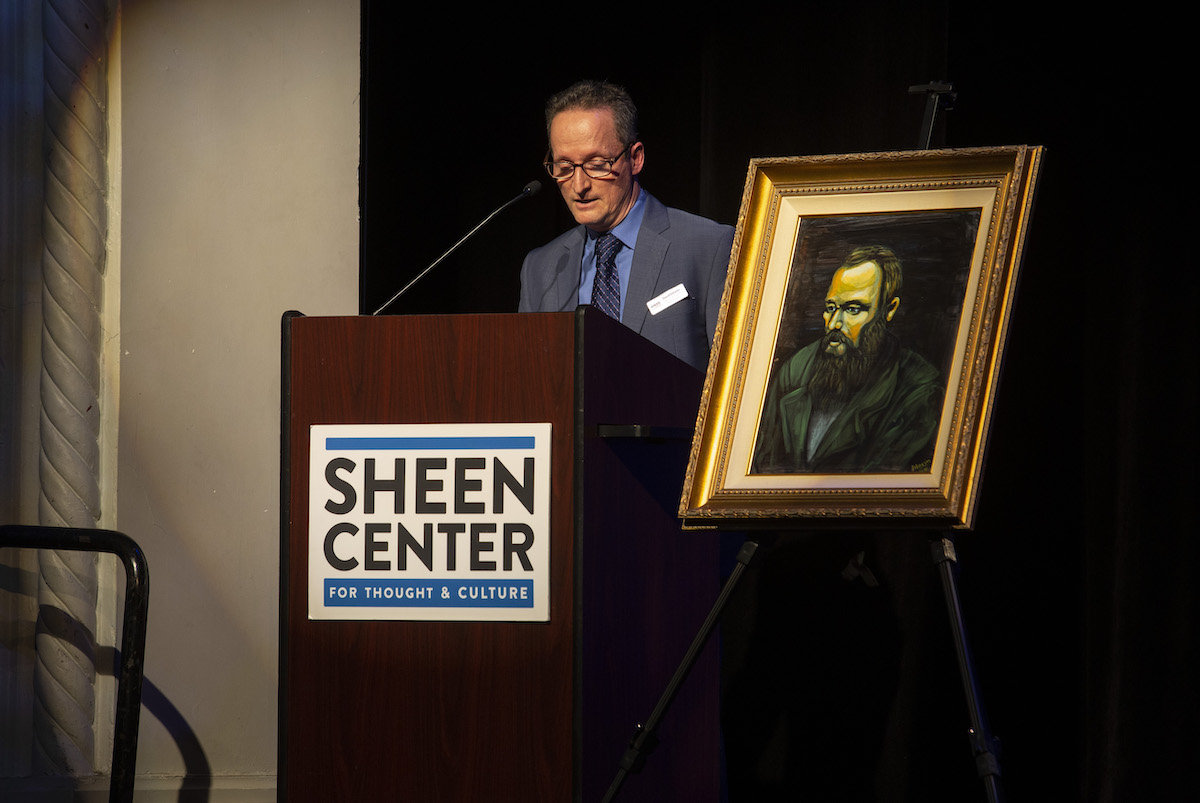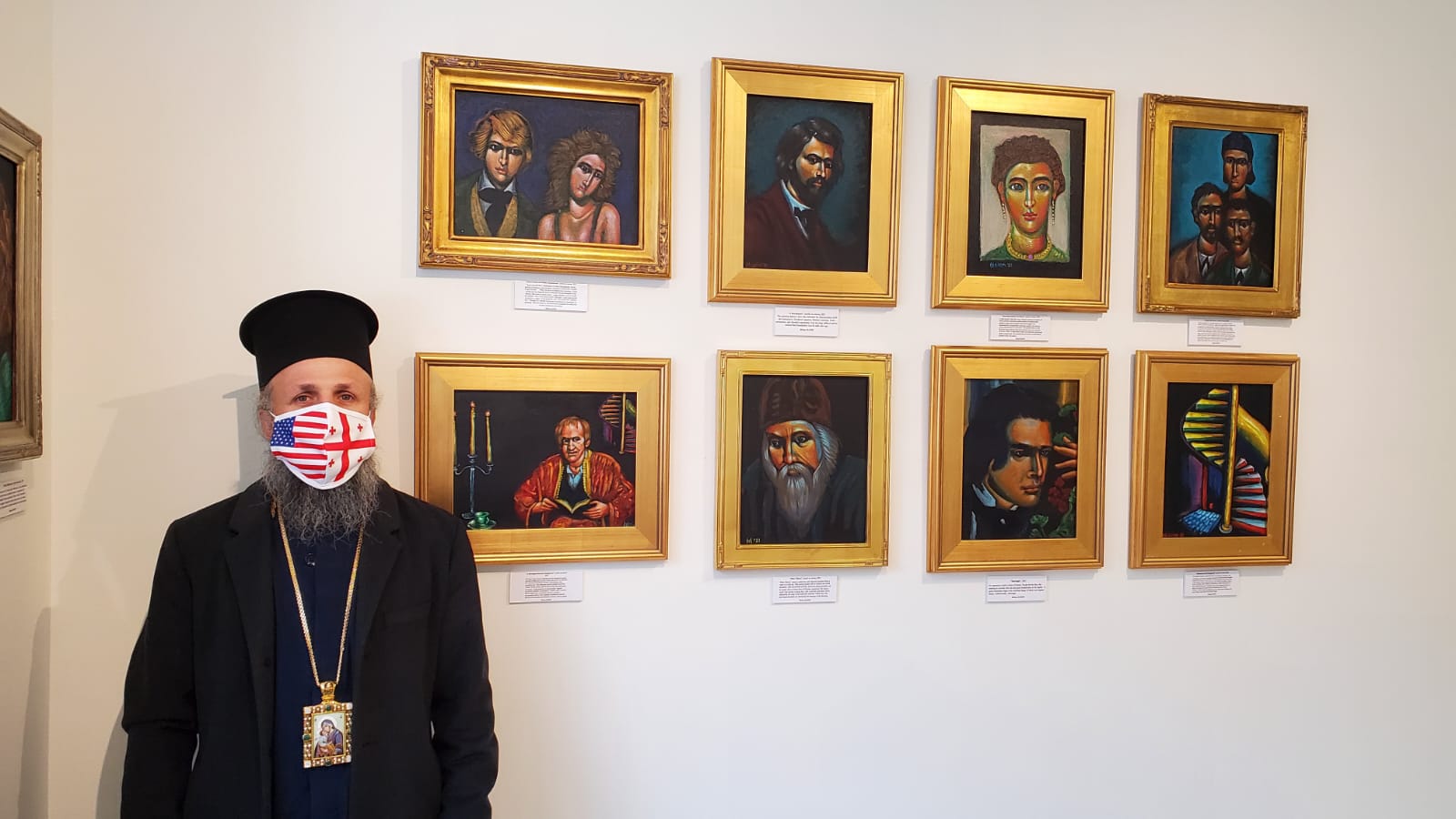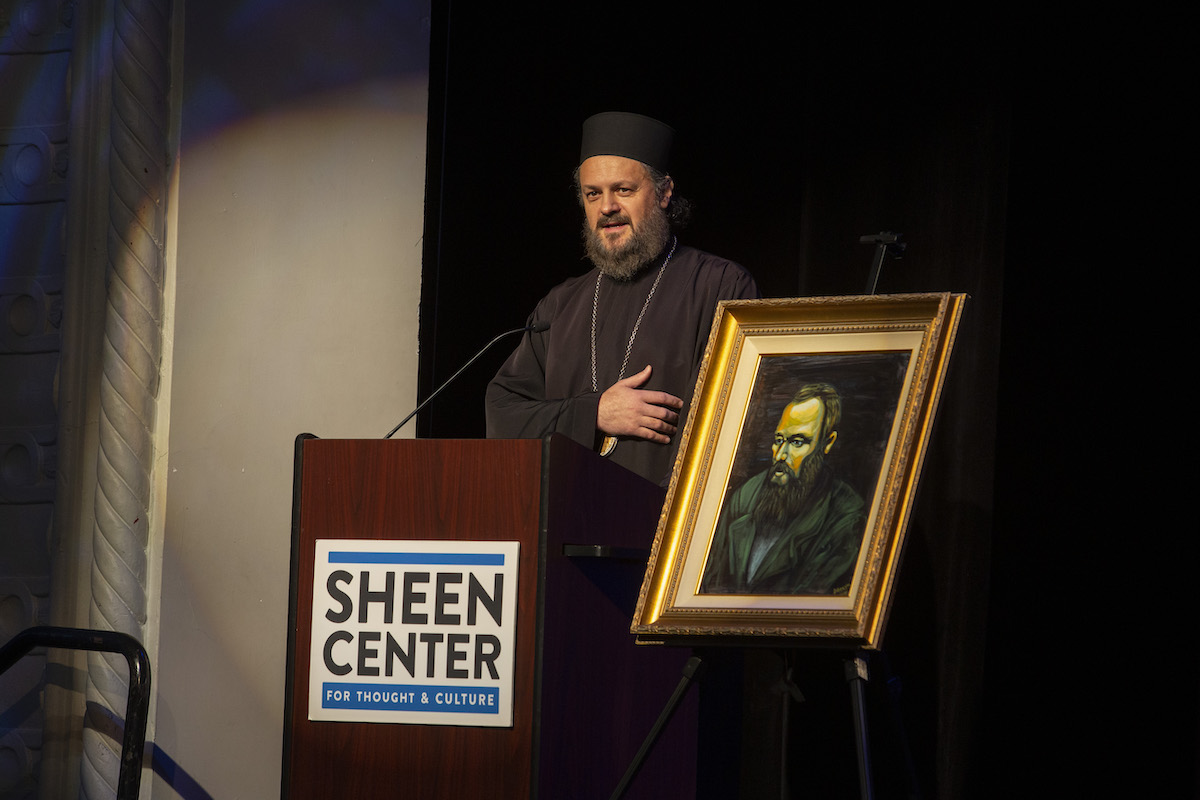Opening Remarks delivered at the Sheen Center Exhibit of “Saved by Beauty: Dostoevsky in New York”
The Sheen Center for Thought and Culture in New York City is hosting an exhibit dedicated to the great Russian writer
New York City, April 5, 2022
The Sheen Center for Thought and Culture in New York City is hosting an exhibit titled “Saved by Beauty: Dostoevsky in New York”. It is a visiual tribute to the 200th anniversary of the birth of Fyodor Dostoevsky (1821-2021) and will last March 18 – April 30, 2022.
Having toured Greece and making its New York premiere at The Sheen Center, this exhibit spans two floors and gives visual expression to characters and existential and moral themes from the novels of Fyodor Dostoevsky through a variety of painting styles by 15 artists. Exhibit is featured at the New, Janet Hennessey Dilenschneider Gallery, and it is presented in collaboration with the Greek Orthodox Archdicese of America and St. Sebastian Press of the Western American Diocese, Serbian Orthodox Church.
These beautiful paintings are now welcome in New York, a city that exemplifies in many ways the extreme contradictions and creative struggles that Dostoevsky successfully described in his writings.
The exhibit features art by the Ochre Group: Fr. Stamatis Skliris, George Kordis, Bishop Maxim Vasiljevic, Babis Pylarinos, Costas Lavdas, Maria Panou, Giannoulis Lymperopoulos, Nektarios Mamais, Fotis Varthis, Konstantinos Kougioumtzis, Christos Kechagioglis, Nektarios Stamatelos, Despina Karantani, George Margaritis, Christina Papatheou-Douligeri. And they are all members of the visual group “OCHRE.”
“OCHRE” is an informal group of painters, who have contributed to the traditional Orthodox iconography but at the same time are in dialogue with the modern artistic trends.
On April 5, a special presentation on the new international art installation was held at the Loreto Theater, 18 Bleeker Street.
In his remarks, read by Archimandrite Nektarios, the Greek Archbishop Elpidophoros said that the title of today’s exhibition uses the past tense to speak of the action of beauty “Saved by Beauty”, however Dostoevsky prefers the future. “Beauty will save the world.” By coming to this Opening tonight, we want to acknowledge the transformative action that beauty and art has had over the world. “Meanwhile, Dostoevsky’s own words resonate like a promise to be fulfilled. The work of beauty as an icon of God’s presence in the world is not over. It has barely started,” concluded the Archbishop.
Bishop Maxim pointed out that the paintings on the walls of the gallery at the Sheen Center show Dostoevsky, a man, dressed in flesh and blood, who lives, suffers, falls, and rises. At the same time, these paintings are a result of a “non-Euclidean” reading of that reality. Fyodor creates art or beauty by confessing what is in his soul, hence its astonishing persuasiveness.
Prof. George Kordis spoke about the attempt of “Ochre” group: “We as artists believe that this artistic language, the Byzantine painting system, has elaborated and has developed for centuries in order for the ethos and the spirit of the ecclesiastical life to be properly render in visual terms. For that reason, we believe that this language can serve the needs for expression of contemporary artists who are looking for a vehicle for expressing their spiritual inquiries.”
The exhibit is characterized by great pluralism. It hosts various currents and artistic trends, which are in a harmonious dialogue with each other. One sees Byzantine elements conversing with impressionist, expressionist, cubist, abstract, as well as features of street art, graffiti, etc. The works emit a deep study and understanding of Dostoevsky’s novels. It is very important that the painters have so seriously studied the great writer and philosopher at a time when electronic images and soap operas distract readers from great and essential works and wider Literature.
The presentation is immediately followed by a reception at the second floor of the Sheen Center.
Given the horrors of the war in the Ukraine, this exhibition reminds the world of its spiritual and cultural inheritance received from the likes of one great Fyodor Dostoyevsky. May it be a blessing to us all!
Read the remarks of Archbishop Elpidophoros, Bishop Maxim and Prof. George Kordis.
April 5, 2022
Sheen Center for Thought & Culture
New York, New York
Ladies and Gentleman,
Dear Friends,
It is such a pleasure to be with you this evening, for this occasion celebrating the Exhibit: Saved By Beauty: Dostoevsky in New York.
Especially at this moment, when a fratricidal war is being waged in the very heart of the Orthodox Soul of Rus’, and we see the hideous images of destruction being wrought by the invaders, we need to glimpse beauty more than ever.
This exhibition is a tonic for the sickening savagery that we are witnessing in Ukraine, a balm for the soul and at the same time a reminder that Russian inspired culture and art should not become the collateral victims of today’s geopolitical tragedy.
Thus, I would like to thank the Sheen Center for Thought and Culture in New York City of the Roman Catholic Archdiocese of New York for hosting this crucial exhibition celebrating the bicentennial of Dostoevsky’s birth in 1821.
My sincere gratitude also goes to His Grace Bishop Maxim of the Western American Diocese of the Serbian Orthodox Church who, a few months ago, mentioned to me that this exhibition was being presented in Greece. It is with great pleasure that we now welcome these beautiful paintings to New York, a city that exemplifies in many ways the extreme contradictions and creative struggles that Dostoevsky successfully described in his writings.
Looking at these paintings, we are never too far from the world of icons. Indeed, a simple icon, rendered magnificently, becomes a polysemous sign with multiple layers of meaning and participates in our worship experience. As a matter of fact, this exhibit features art by the Ochre Group, which is a group of contemporary painters whose members share a love for the art of iconography and its centuries-long history.
Dostoevsky walks the road to the Kingdom by exploring the multifaceted dimensions of human tragedy. The free man is enslaved by the external forces that dehumanize its ultimate being. The struggle between light and darkness brings forward the oxymoronic complexity of the person. The faithful don’t know God, whereas the atheist only speaks about religion. He looks into the soul of humanity and finds hell and paradise cohabiting. This graphic experience of paradox, of the in-between, is what makes his work so phenomenal and this exhibition so important, as it tries and succeeds in capturing through shapes and colors the depth of the human soul.
I am also particularly happy that in addition to the exhibition itself, a captivating conversation with Professor Peter Bouteneff from St. Vladimir’s Orthodox Theological Seminary, George Kordis a world-renown iconographer, and Professor Michael Ossorguin from Fordham University, will take place on April 12 at the Sheen Center featuring the intersectionality of faith, art and culture.
Ladies and Gentlemen, Dear Friends,
The title of today’s exhibition uses the past tense to speak of the action of beauty “Saved by Beauty”, however Dostoevsky prefers the future. “Beauty will save the world.” By coming to this Opening tonight, we want acknowledge the transformative action that beauty and art has had over the world. Meanwhile, Dostoevsky’s own words resonate like a promise to be fulfilled. The work of beauty as an icon of God’s presence in the world is not over. It has barely started.
I hope you will all enjoy this Exhibition. Thank you for your presence tonight and thank you for your kind attention.
A talk delivered at a painting exhibit “Saved by Beauty: Dostoevsky in New York”
at The Sheen Center, New York, April 5, 2022
Your Eminence Timothy Cardinal Dolan, Archbishop of New York of the Roman Catholic Church,
Your Grace Bishop Irinej of Eastern America of the Serbian Orthodox Church,
Very Reverend Archimandrite Nektarios Papazafiropoulos, Chancellor of the Greek Orthodox Archdiocese of America,
Kindly allow me to congratulate The Sheen Center for Faith and Culture and Mr. David DiCerto for welcoming the idea of hosting an exhibit during the Paschal Spring in the Big Apple dedicated to Fyodor Mikhailovich Dostoevsky. Having toured Greece and making its New York premiere at The Sheen Center, this exhibit spans two floors and gives visual expression to characters and existential and moral themes from the novels of Fyodor Dostoevsky through a variety of painting styles by 15 artists.
My sincere gratitude goes to His Eminence Archbishop Elpidophoros of the Greek Archdiocese, who embraced the proposal of sponsoring and promoting this crucial exhibit.
I thank St. Sebastian Press & Art from Los Angeles and its manager Ms. Radmila Bojovic for taking upon her shoulders the burden of preparing this visual tribute to the 200th anniversary of the birth of Fyodor Dostoevsky (1821-2021) in the USA by transferring the works from Athens to Los Angeles, New York, Boston, etc.
Indeed, I am greatly delighted that I can be here tonight with all of you, who so cherish and appreciate Beauty, which will truly Save the World!
The bicentenary celebration of the birth of the great Russian author Fyodor Dostoevsky, considered one of the most outstanding writers of modern literature, has found the world in an increasing state of bewilderment. Some, including myself, believe that the dynamic and open anthropology of this classic can help rectify an issue because it has the power to break the defensive armor of the modern ego and take us beyond its ideological constraints.
The paintings on the walls of this gallery show Dostoevsky, a man, dressed in flesh and blood, who lives, suffers, falls, and rises. At the same time, these paintings are a result of a “non-Euclidean” reading of that reality. Fyodor creates art or beauty by confessing what is in his soul, hence its astonishing persuasiveness.
The depth and contradictoriness of his heroes have made systematic psychological theories look shallow by comparison. Aware of the relativity of categories of morality in human life, this Russian writer was the first to show that the physical and psychological boundaries within the context of human diversity are neither so clear nor unyielding.
The painters of the visual group “OCHRA” have attempted to visually express this world of hopeless, dark heroes and others, positive heroes, who have experienced repentance. According to Fr Stamatis Skliris, “this exhibition shows many visual trends. Some works are more emotional and more romantic, or even darker. Some seek to describe scenes from Dostoyevsky’s novels; some are portraits of his heroes, others, more existential, penetrate the Dedicated streets of the psychic world, while some move into a spiritual bullet showing spiritual points and messages broadcasting the work of the great writer. The entire exhibition awakens our spiritual restoration and serves as a reminder of the first literary adventures of the psychological novel. It expresses nostalgia for the great literary genre called novel, which was popular in the author’s years, and nowadays it fades away.”
Fyodor Mikhailovich Dostoevsky’s work is like a submarine diving into the bottomless depths of the human soul and photographing its Dedalian landscapes to present them before our eyes as a realistic image of enigmatic existence, which, as long as there is, fights nonexistence.
Dostoevsky’s sense of evil and his love of freedom made him especially relevant in a century of world wars, mass murders, and totalitarian systems.
His portrait suggests a person who lived the experience of seeing an abyss before him, and he looks at nothingness directly with his eyes. The great writer is characterized by eternal restlessness of spirit, and he insists (constrained by this effort) on a twofold feeling that we would call, “waiting for the arrival of nothingness.” It is as if he is above the abyss and watching his pens and notebooks flee, his table sliding, and his body, his house, above the abyss. He lived this feeling so intensely that it permeates his existence with the atmosphere of various scenes that he creates with his imagination in his work.
The gaze of the long-suffering, but blessed Dostoevsky crystallizes in that portrait. When we look at him and his eyes and then his torn coat, we can say: this man has gone through a storm, yet his eyes possess a sweetness that says: Thank God, we are saved!
Therefore, according to Metropolitan John Zizioulas, “Dostoevsky brings us to the edge of the abyss but does not leave us to fall into the abyss.” And Dostoevsky’s message to everyone is: “Compassion is the most important and, perhaps, the only law of existence for the whole of all mankind.” In his prodigious literary works, this Russian novelist and short-story writer refer to repentance and redemption as preconditions of becoming God-like.
And I truly hope that there will be more members and successors of the “Ochra group”, who will continue this work deeply inspired of the exceeding marvelousness of Dostoyevsky’s insight.
May I, once again, express my profound gratitude to The Sheen Center, which has fostered this exhibition, and I say that also as a Bishop of the Serbian Orthodox Church, expressing as such, the appreciation of His Holiness our Serbian Patriarch Porfirije.
Thank you very much!
Greeting at The Sheen Center in New York City, April 5, 2022
George Kordis
Good evening!
I am really very glad and moved and I feel deeply honored to be part of this beautiful exhibition.
First of all, I would like to express my gratitude to His Eminence the Archbishop of the Greek Archdiocese Elpidophoros and to His Grace the Serbian Bishop Maxim of Western Amerika for organizing this exhibition of the artworks of the group “Ochra”. Of course I want to express many thanks to The Sheen Center for offering us the chance to expose the art we have created for honoring the memory of the great writer and thinker Fyodor Dostoevsky.
On behalf of the group “Ochra” I would like to say few words about this group, consisted mostly of Greek artists and few words about the art we have produced specifically for this event.
The group “Ochra” was established in 2018 in Athens and its main goal is to continue the traditional Byzantine style painting in our postmodern world. Based on the belief that this style is a complete and integrated painting system the artists joined the group attempt to use this artistic language not only in rendering religious themes, but in visualizing the contemporary life, the feelings, and the anxieties of contemporary people and mostly to capture and render in visual terms their hopes and their vision for a better world. A world characterized by reconciliation, peace, love and above all by the unity of a community.
We as artists believe that this artistic language, the Byzantine painting system, has elaborated and has developed for centuries in order for the ethos and the spirit of the ecclesiastical life to be properly render in visual terms. For that reason, we believe that this language can serve the needs for expression of contemporary artists who are looking for a vehicle for expressing their spiritual inquiries.
Byzantine painting tradition, which was and is always open to a dialogue with other contemporary artistic trends, is a good and suitable language for presenting the daily life, the nature and the human adventure in a mode that elevates everything at a stage of sacredness.
The exhibition for Dostoyevsky was an idea of His Grace Bishop Maxim Vasilievic. The artists of the group immediately embraced this idea and worked each one in his own particular style and with different artistic media. Some artists tried to picture a portrait of the great writer and some others attempted to illustrate characters of his novels. All of them, as I believe, respected Dostoevsky’s spirit and the atmosphere of his narrations.
The exhibition is an homage to the great writer, and I would like to believe that is the first but not the last of events that the Orthodox Church in the USA will organize in order good quality arts to become again part of the daily life of people and simultaneously organic part of the ecclesiastic life.
Thank you!

